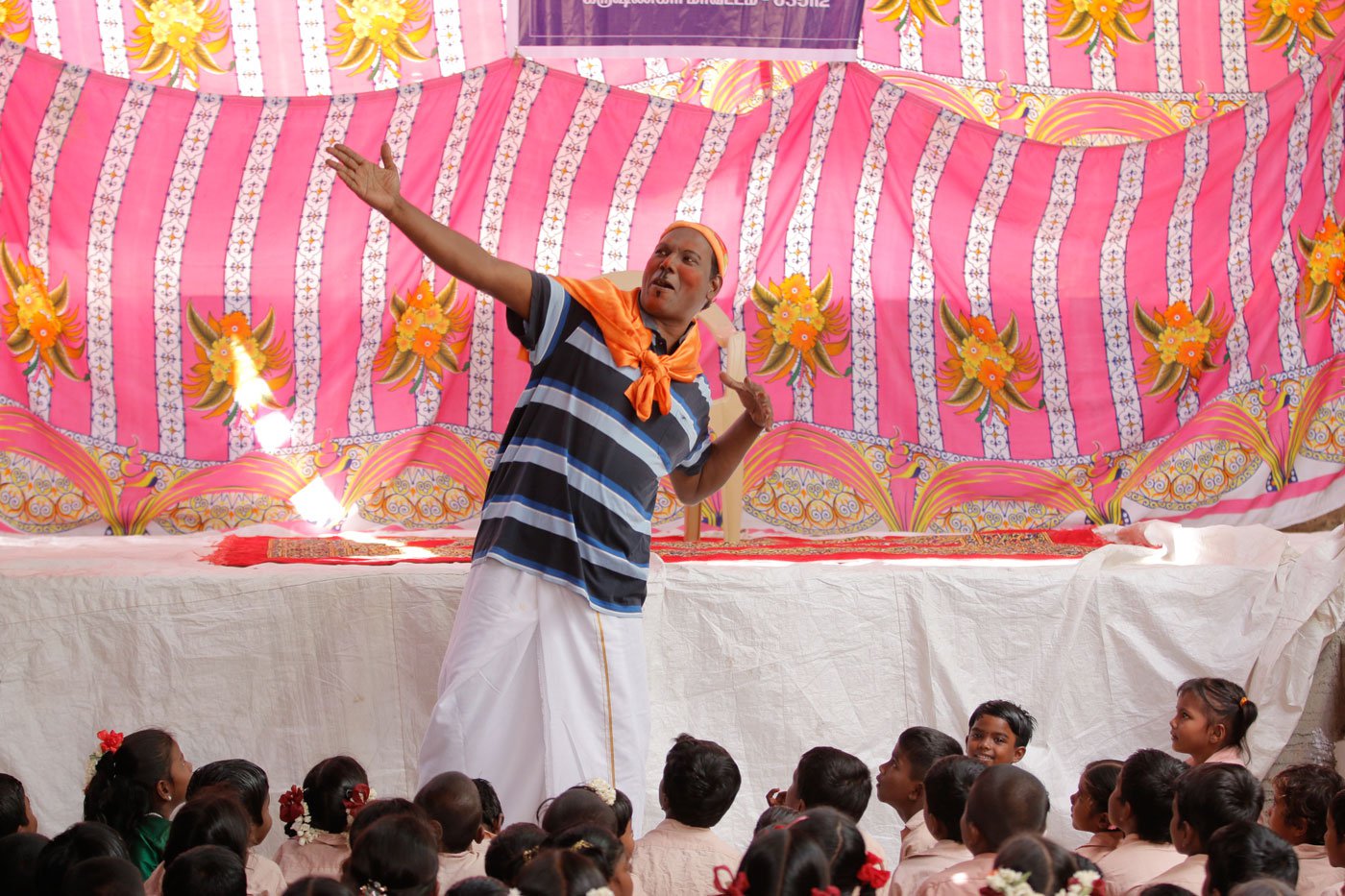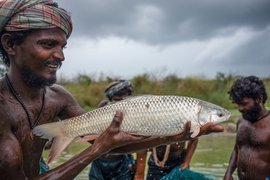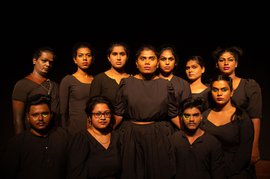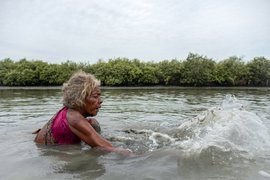Ezhil anna ’s memory grips me tight and pulls me along a stream with a magical force. It takes me past colourful forests full of shadows that sing, amidst tall dancing trees, into stories of gypsy kings, and onto a mountain top. From there the world seems dream-like. Then, suddenly, anna [elder brother] throws me into the cold night air among the stars. He pushes me towards the ground until I turn into clay.
He was made of clay. His life was like that. A clown, a teacher, a child, an actor, he was flexible as clay. Ezhil anna , he made me from clay.
I grew up in the tales of the kings he told the children. But now I need to tell his story, the one behind the man and his photographs. The story that has been living inside of me for more than five years.
*****
R. Ezhilarasan is the king of clowns, a rat jumping around, a colourful bird with a frown, a not-quite-wicked wolf, a lion prancing about... It all depends on the story of the day. Stories that he has been carrying around for more than three decades in a large green bag on his back as he travels through forests and cities across Tamil Nadu.
It is 2018. We are in a government school campus in Nagapattinam. Stacks of logs lying around, cut from the trees uprooted by Cyclone Gaja, make the school campus look more like an abandoned sawmill. But this desolate and battered look worn by the campus in this worst affected district of Tamil Nadu is getting peeled off from one corner with excited squeals of laughter from children.
“Vandhane thenna paarunga kattiyakkaaran aamaa kattiyakaaran. Vaaraane thenna paarunga [Look, the clown has come, yes, the clown is coming, look].”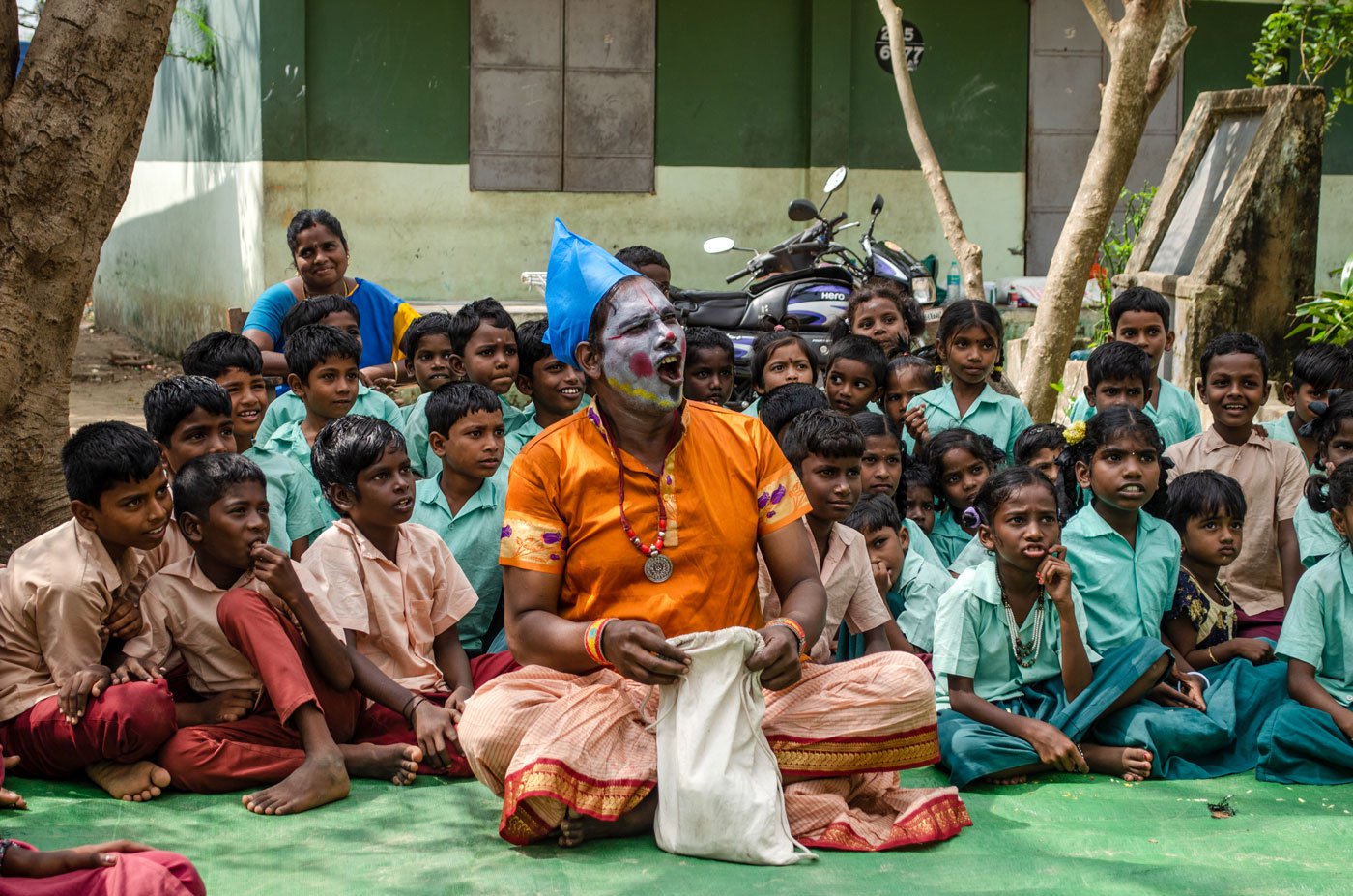
Ezhil
anna
sits with children before preparing them for a play, asking them questions about their interests
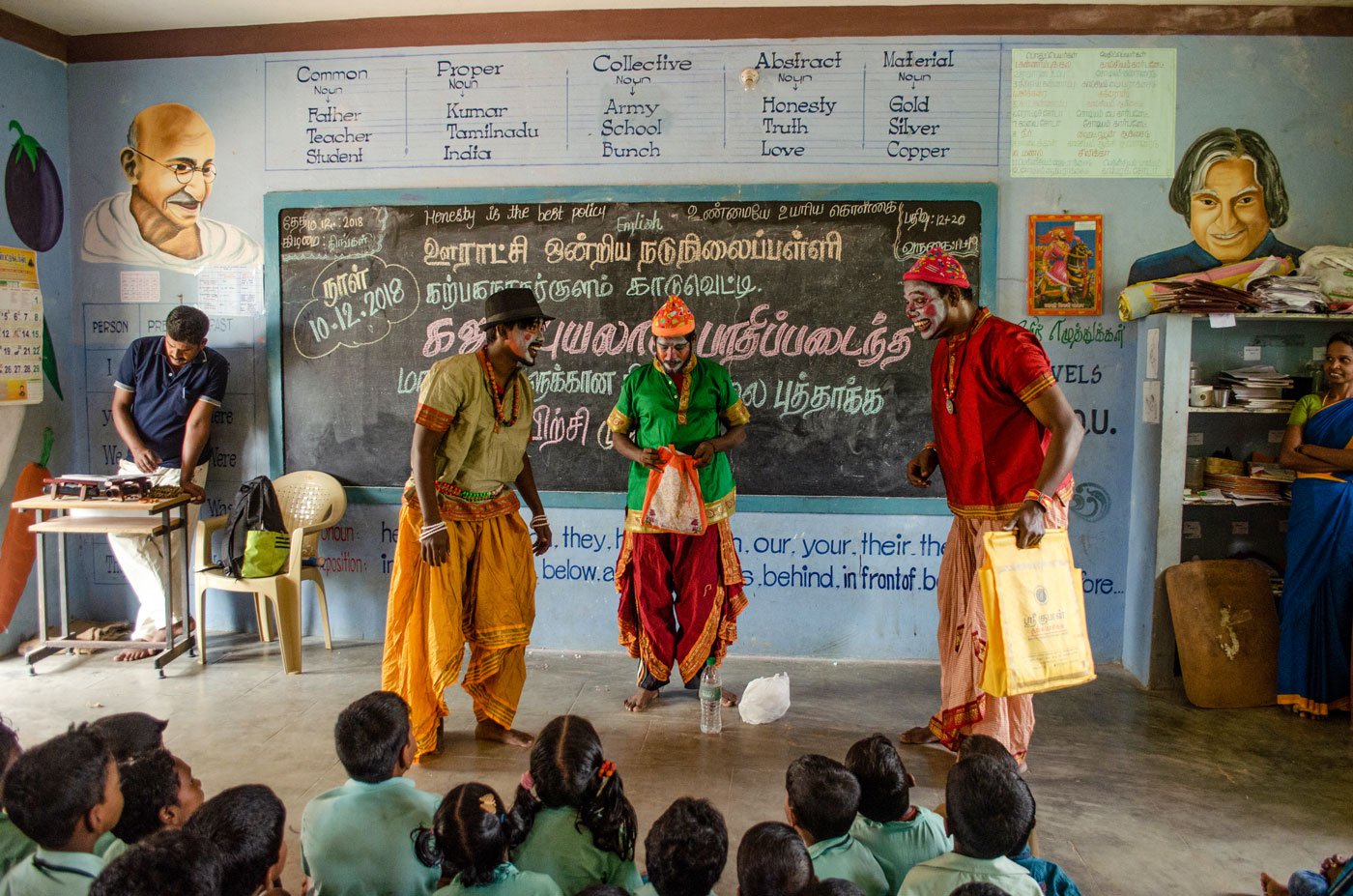
The art camp he conducted in Nagapattinam after Cyclone Gaja in 2018 brought the children and their laughter back into the classroom
Face painted in white and yellow, three red dots – one on the nose and two on the cheeks, a sky-blue plastic bag for a clown cap on the head, a funny song on his lips and a carefree rhythm in his limbs – he looked like a laugh riot. The hullabaloo was usual. This is how Ezhil anna ’s art camps begin, be it in a small public school in Javadhu hills, or a swanky private one in Chennai, a remote one for tribal kids in Sathyamangalam forests [Erode district], or one for children with special needs. Anna has burst into a song, a small skit, which helps the children leave their inhibitions behind as they run, play, laugh, and sing along.
A trained artist, anna is never concerned about the facilities available at the schools. He asks for nothing. No separate hotel or lodging arrangements, no special equipment. He even works without electricity, or water, or fancy craft materials. He only cares to meet the children, to communicate, to work with them. Everything else takes a backseat. You cannot take the children out of his life. He is a man of charm and action when it comes to kids.
Once, in a hamlet in Sathyamangalam, he worked with children who had not seen colours before. He helped them use colours to create something out of their imagination for the very first time, discover a new experience for themselves. He has been creating these experiences, tirelessly, for children since the last 22 years, from the time he began his art school, Kaliman Viralgal [Fingers of Clay]. I have never seen him giving in to sickness. His cure is his work with children, and to show up among them, he would be forever ready.
Anna completed his Bachelor’s degree in Fine Arts from Chennai Fine Arts College in 1992. “My seniors, painter Thiru Thamilselvan,” he recollects, “costume designer Mr. Prabhakaran and painter Mr. Rajmohan, were incredibly supportive of my college life. They helped me complete my degree. After a course in terracotta sculpture, I joined the Lalit Kala Akademi in Chennai to experiment with art.” He also worked at his sculpting studio for a while.
“But when my works started to sell,” he says, “I realised they were not reaching the ordinary people. That is when I started engaging in artistic activities with the masses, and decided that the rural areas, the five lands of Tamil Nadu [hills, sea, desert, forest, fields], were the places where I wanted to be. I started working with children, making toys with clay and handicrafts.” He started teaching children how to make paper masks, clay masks, clay models, drawings, paintings, glass paintings and origami.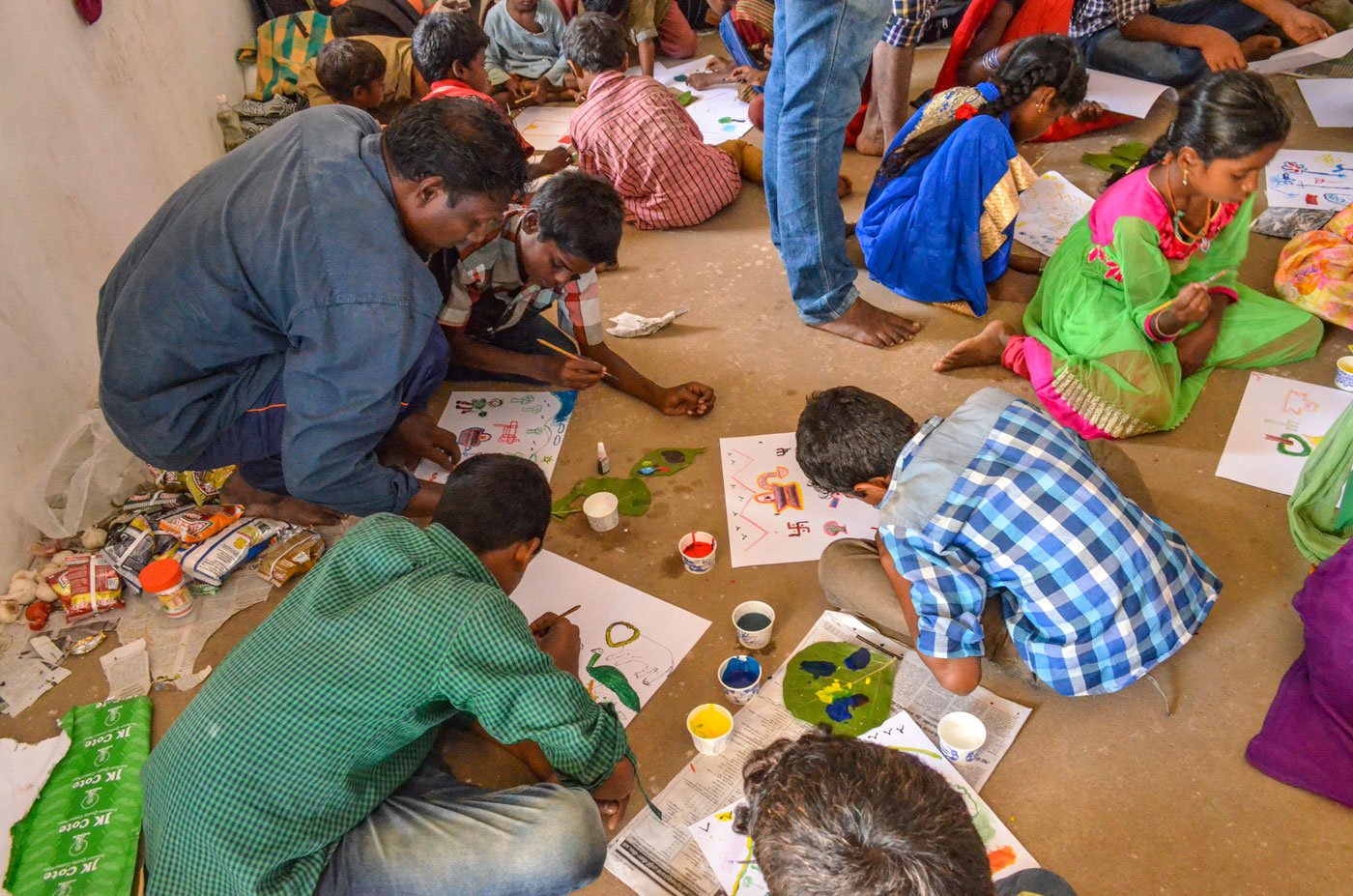
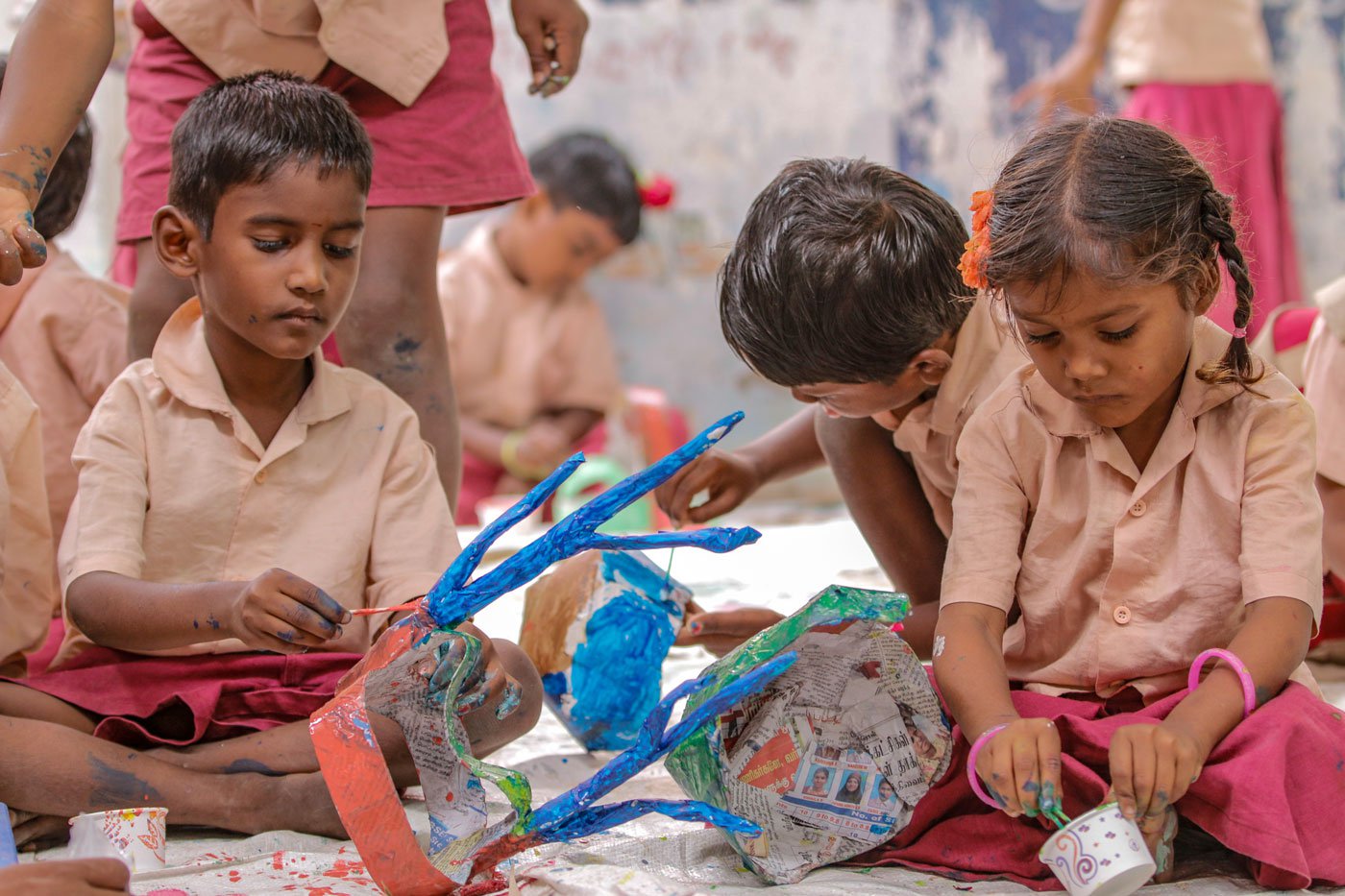
Left: The children in Sathyamangalam, Erode district, being introduced to the magic of colours for the very first time. Right: Children in Kaveripattinam, in Krishnagiri district, making deer crowns using cardboard and newspaper
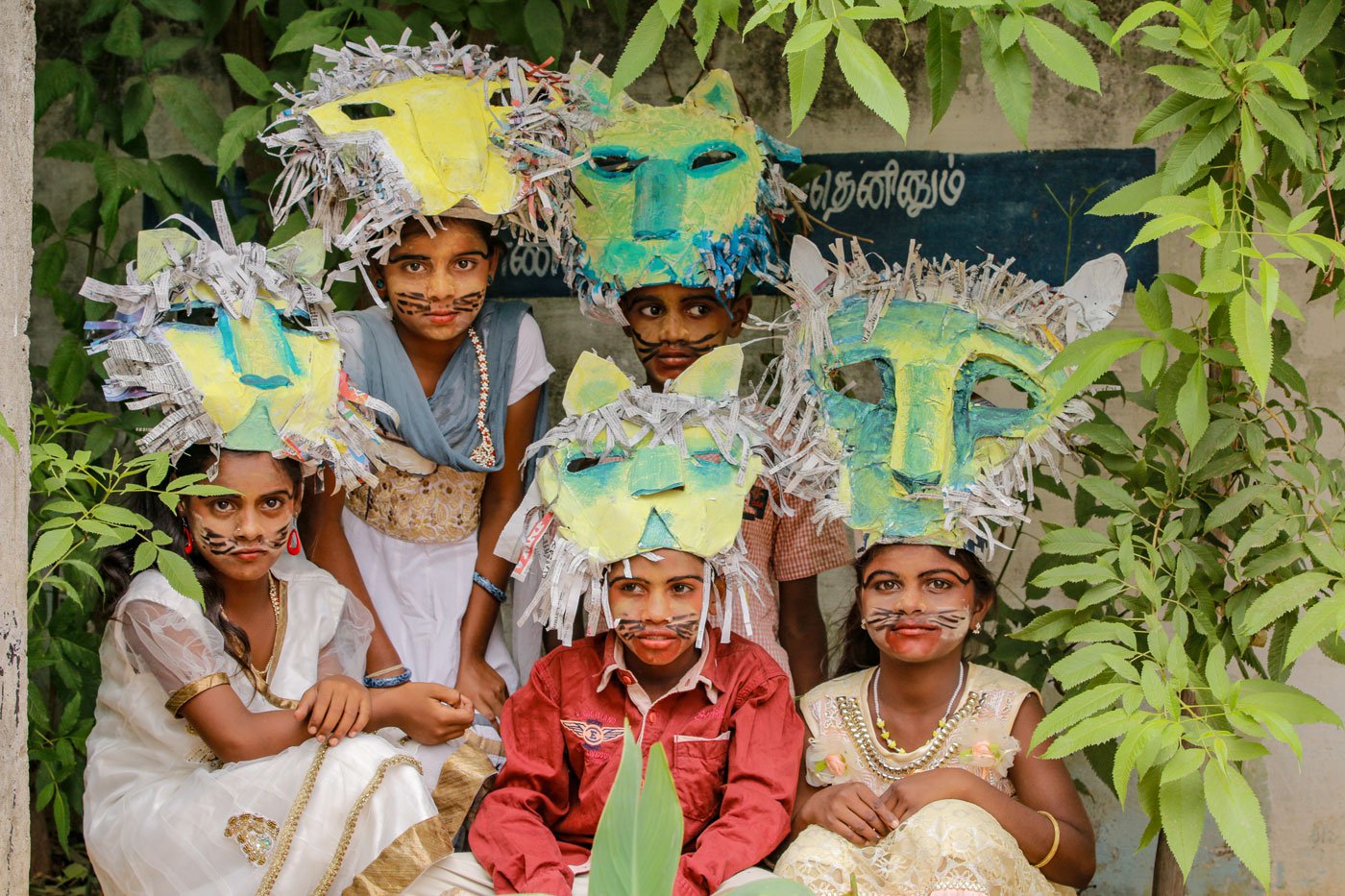
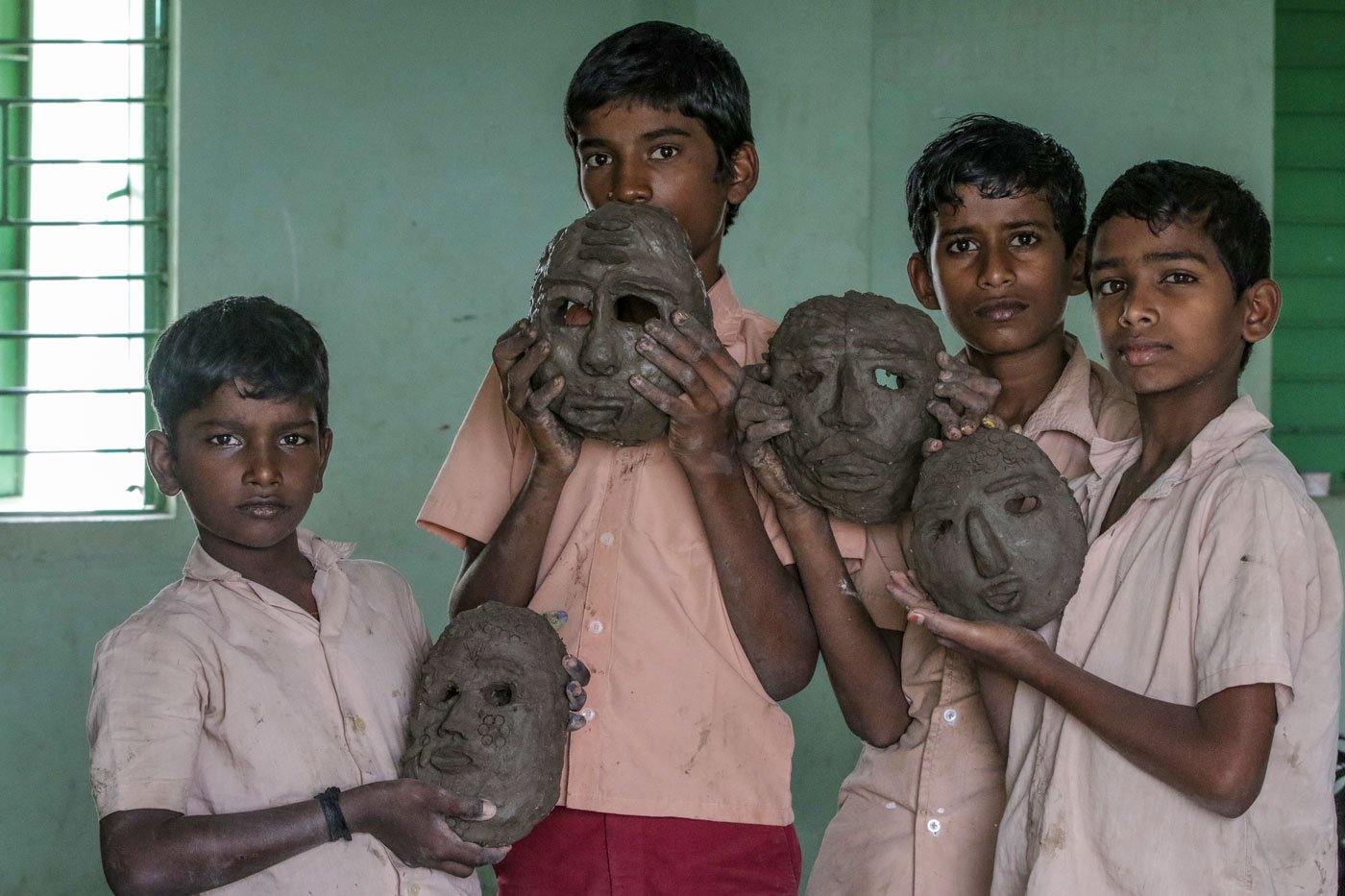
Left: Children wearing headgear designed and made by them, for the play that was performed on the last day of a workshop in
Kaveripattinam
. Right: Children in Perambalur displaying clay masks they made, each with a unique expression
Whenever we travel, whatever mode of transport – a bus, a van, or whatever is available – our biggest luggage would always comprise of things for children. Ezhil anna ’s green bag would be bursting with drawing boards, paint brushes, colours, fevicol tubes, brown board, glass paints, paper and umpteen other things. He would have taken us to every possible neighbourhood in Chennai – from Ellis Road to Parry’s Corner, to Triplicane to Egmore – where one could find an art supply store. And by then our legs would be hurting. Our bill would run into 6,000-7,000 rupees.
Anna never had enough money. He would raise it from friends, from small jobs, from his own work with private schools, so that the tribal children and children with disabilities could have free art camps. In the five years that I have been travelling with Ezhil anna , I have never seen him lose his zest for life. He has never thought of saving anything for himself, not that he had anything left to save either. Whatever he earned, he would share it with co-artists like me.
Sometimes, instead of buying, anna would discover new materials to teach children all that he thought the education system had failed to teach them. He would also get them to use local material to make artworks. Clay is easily available, and he would often use it. But he would process it himself, from removing the silt and stones, to breaking the clumps and dissolving them, sieving, drying, and all. Clay reminds me of him and his life. Intertwined with the lives of kids, and flexible. It is thrilling to watch him teach the kids how to make masks. Each mask will have a unique expression on it, but the children’s faces will all wear the same expression of pure joy.
The happiness when kids pick up clay and shape it into a mask is priceless. Ezhil anna would get them to think of ideas that are related to their lives. He would keep asking the kids about their interests, urging them to follow them. Some children would create water tanks because their home had little or no water. Some others would opt for elephants. Children from the forests would create elephants with their trunks raised, symbolising their beautiful relationship with the pachyderms.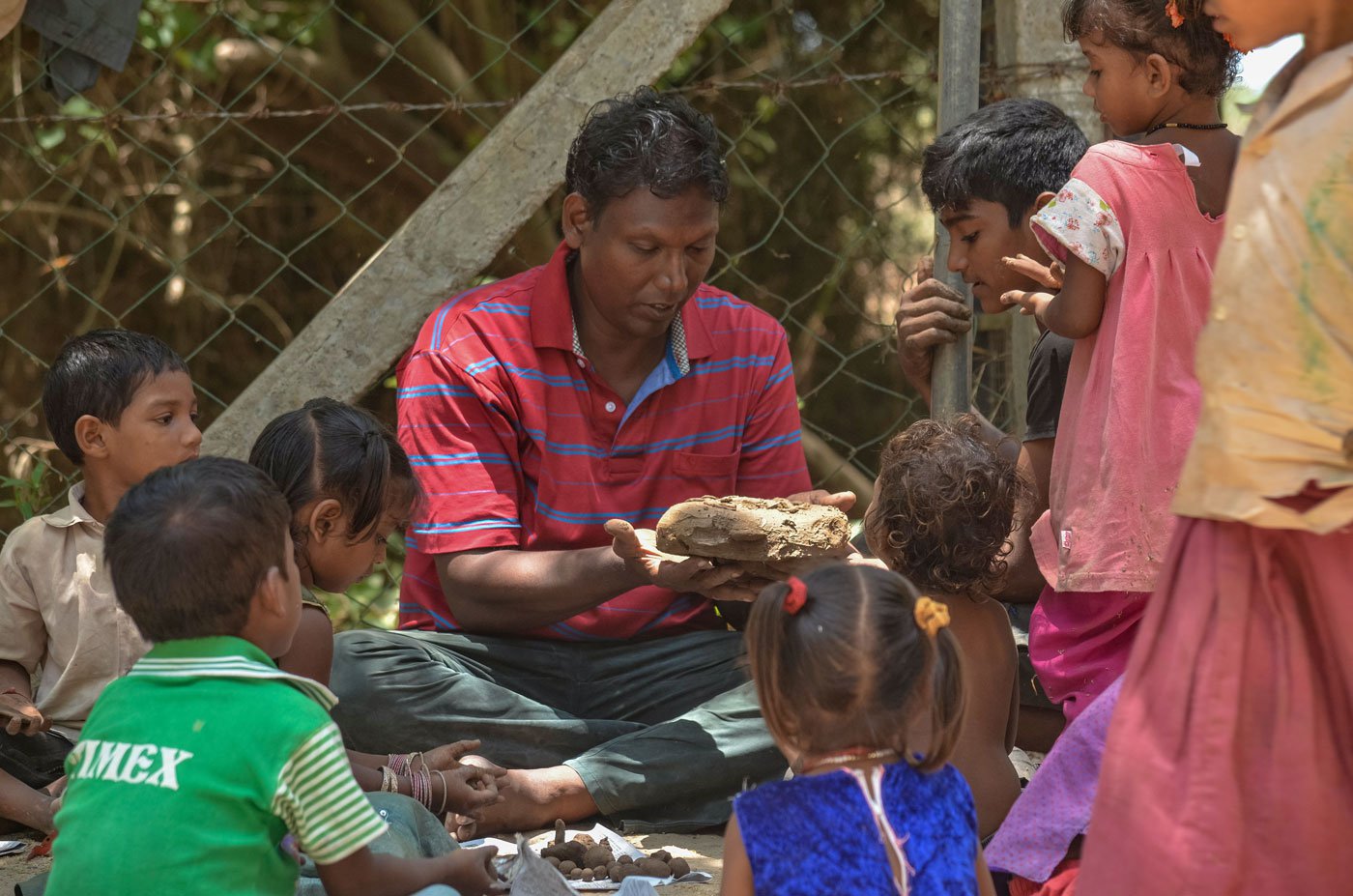
Clay always reminds me of Ezhil anna and his life with kids. He is himself like clay, flexible. It is thrilling to watch him teach kids how to make masks, like here in a school in Nagapattinam
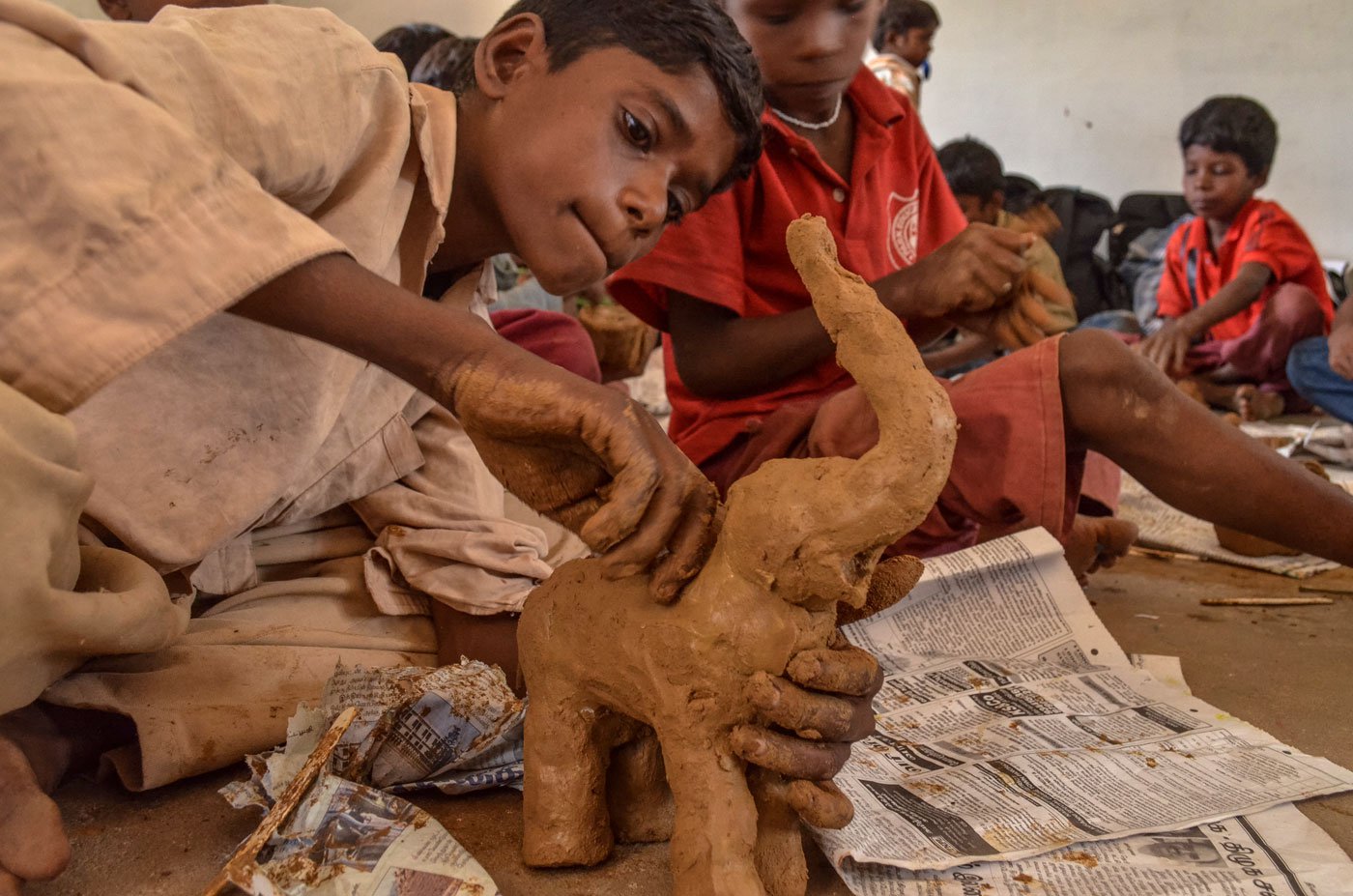
He gets children to bring images and ideas from their own lived world into the artworks they create. Like this child in a tribal hamlet in Sathyamangalam, who's made a clay elephant with a raised trunk, the way he has seen the animal
He would give careful thought to the material that he would use for art camps. His desire for perfection, the concern about delivering the right kind of materials to the kids, made him a hero to us. Every night of the camp, Ezhil anna and others would create props and materials for the next day. He would tie his eyes before a camp with visually challenged children to learn how to communicate with them. He would plug his ears before training hearing-impaired children. The way he tried to understand the experiences of his students inspired me to engage with the subjects of my photographs. It was important to connect with them before I could click.
Ezhil anna had understood the magic of balloons. The games he played with balloons always helped him build a rapport with little boys and girls. In his bag, he would pack loads of balloons – big round ones, long snake-like ones, twisting ones, whistling ones, water-filled ones. They created a lot of excitement among children. And then there were songs.
“In the course of my work, I have realised that the children constantly need songs and games, I come up with songs and games that also have social messages. I make them sing along,” says anna . He would light up the place. Children from tribal villages would find it difficult to let him go after the camp. They would ask him to sing songs. He would sing tirelessly. Kids would be around, so would be songs.
The way he tried to communicate and understand the experiences of his students inspired me to engage with the subjects of my photographs. Initially, when my understanding of photography was still at nascent stage, I showed my photographs to Ezhil anna . He told me to take my photographs to the people who inhabited those frames. “They [the people] will teach you to take your skill to the next level,” he said.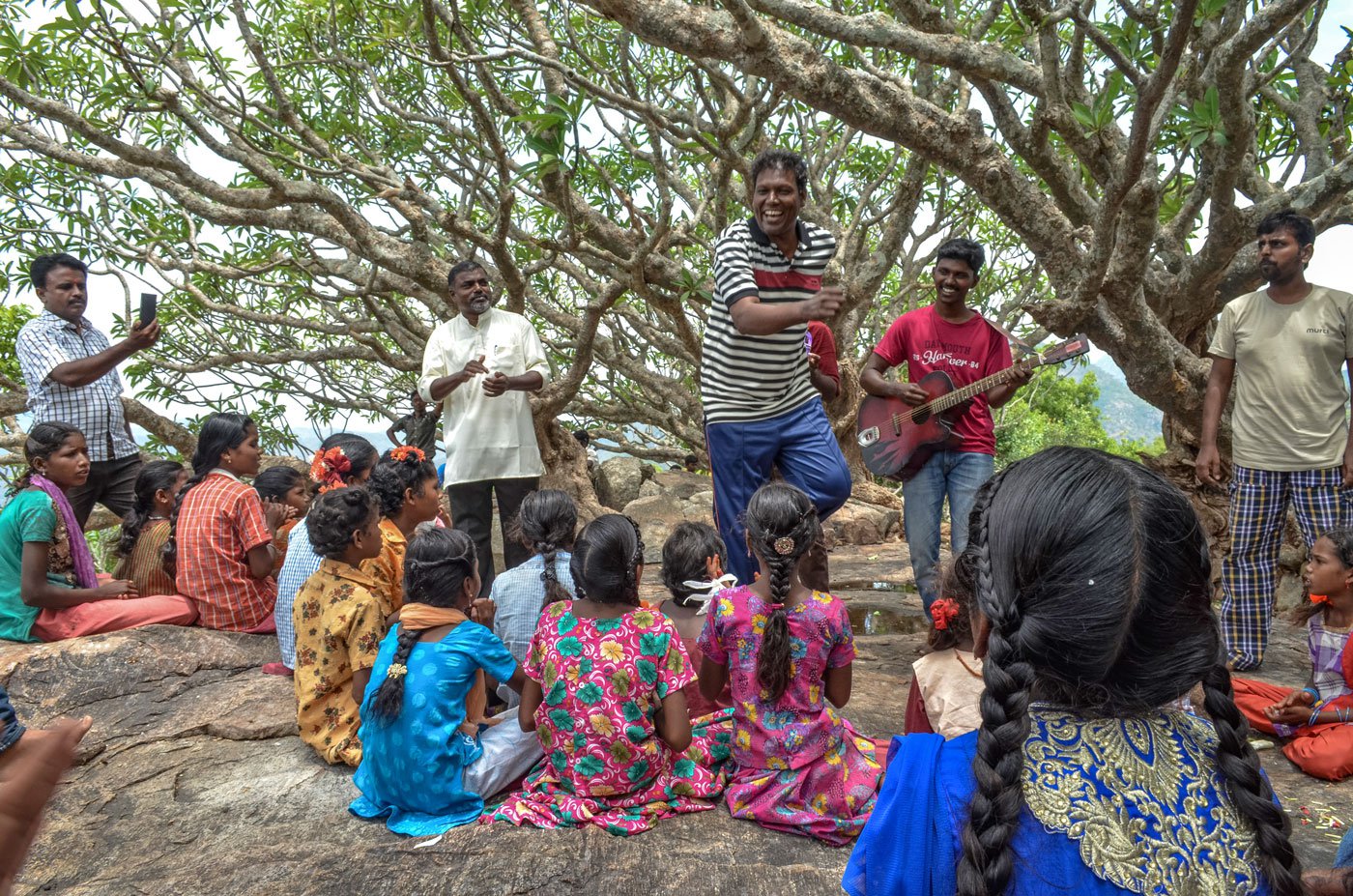
Children often don’t want Ezhil anna to leave after the camp. ‘Children constantly need songs and games. I make them sing along’
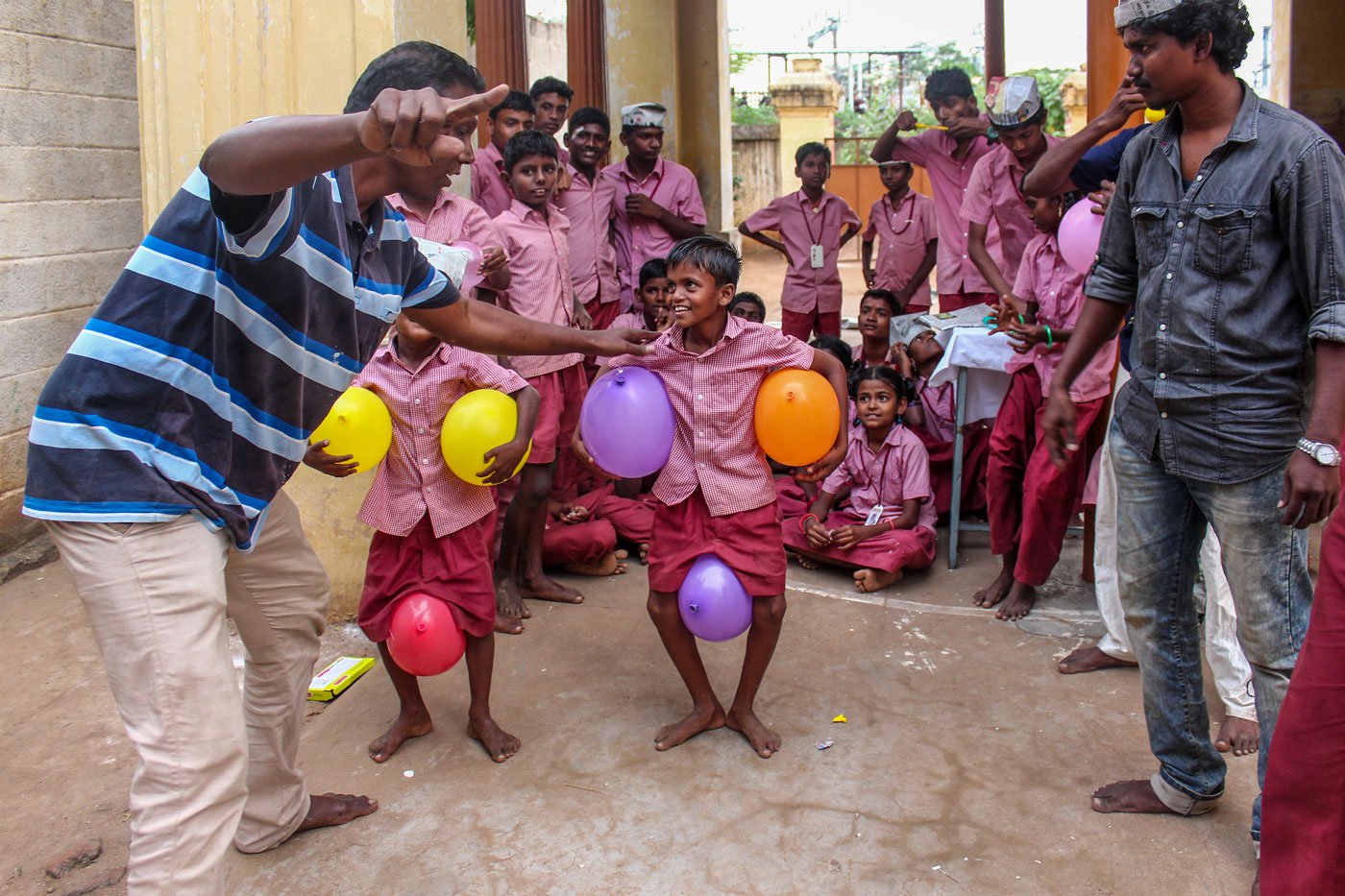
In Salem, playing a
game of balloons
in a school for hearing-impaired children
In the camps, kids always displayed their creativity. Their paintings, origami and clay dolls were displayed. The kids would bring their parents and siblings and proudly show off their talent. Ezhil anna would make it into a celebration for them. He made people dream. My first photography exhibition was one such dream that he nurtured. It was from his camps that I drew my inspiration to organise it. But I didn’t have any money for it.
Anna would advise me to keep my prints ready whenever I had some money. He told me I would make it big. He would tell people about me. He would tell them about my work. I think everything started working out for me after that. Kruna Prasad, the theatre artist and activist in Ezhil anna ’s group, gave me the seed money of 10,000 rupees. I was able to print my photos for the very first time. Anna taught me how to make wooden frames for my photographs. He had a clear plan, without which I wouldn’t have had my first exhibition.
The photographs later reached Ranjith anna [Pa. Ranjith] and his Neelam Cultural Centre. It reached many other places across the world, but the place where the idea first germinated was Ezhil anna ’s camp. I wasn’t aware of many things when I first started travelling with him. I learnt a lot on the journey. But he wouldn’t ever discriminate between those who knew things and those who didn’t. He would encourage us to bring people, didn’t matter if they were less talented. “Let us introduce them to new things, let us travel with them” he would say. He can never see the shortcomings of a person. And that is how he made artists.
He made artists and actors out of the kids also. “We teach the hearing-impaired kids to feel the art forms – we teach them to paint, to create lives from clay. For visually challenged kids, we teach them music and theatre. We also teach them to sculpt three-dimensional sculptures in clay. This helps the visually challenged children to understand the art. We could see that when children learn such art forms, learn them as part of their understanding of society, they also feel independent,” says anna .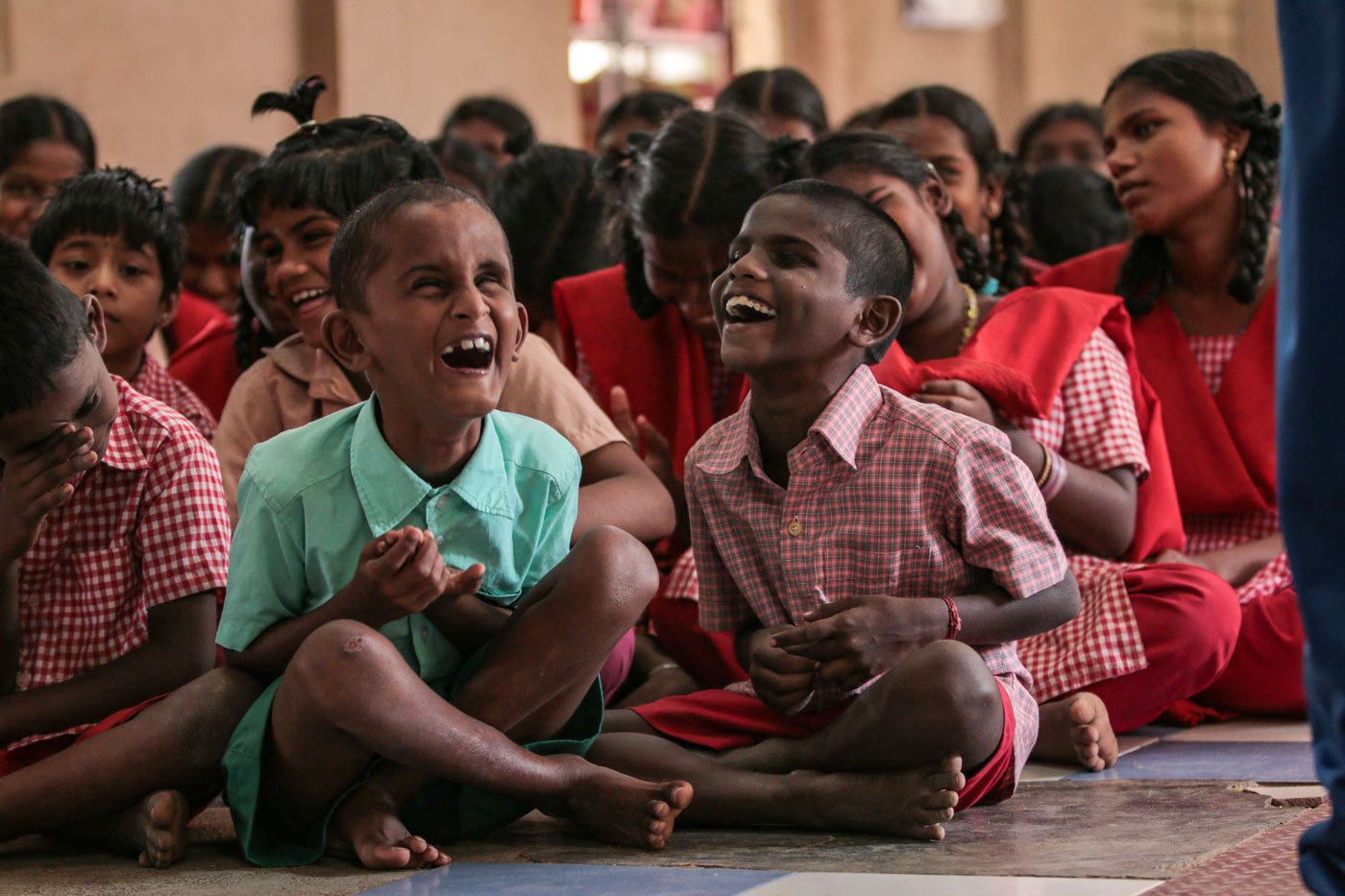
Children at a school for the visually challenged in Thanjavur enjoying their time with Ezhil anna . He ties his eyes before he begins the camp, to learn how to communicate with them. He also plugs his ears while working with hearing-impaired children
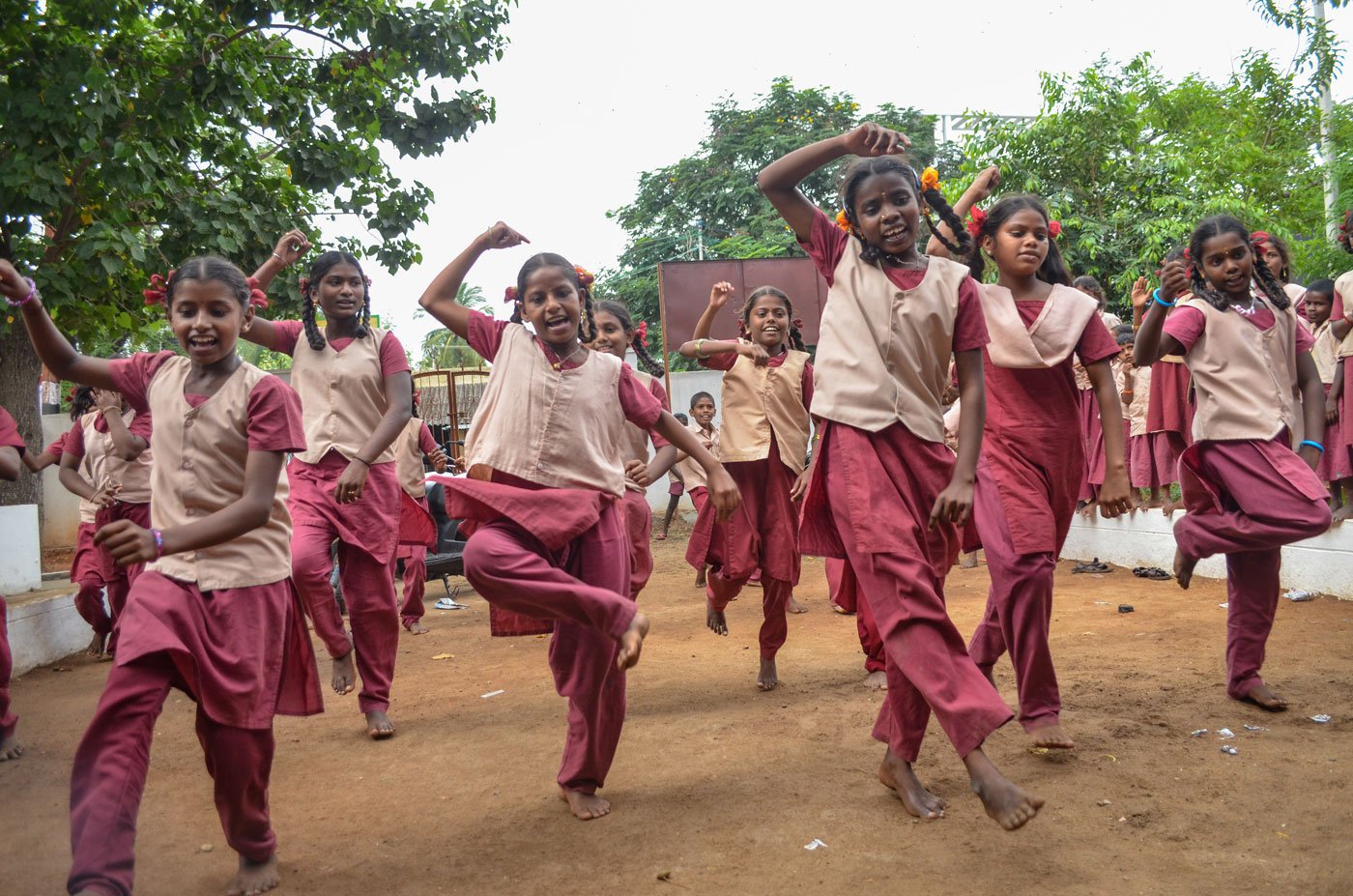
Children practicing oyil attam , a folk dance, in Kaveripattinam. Ezhil anna introduces kids to several folk art forms
In the course of his work, he also realised that “children from villages – especially girls – were too shy even in school. They refused ask any questions or raise doubts in front of the teacher.” He says, “I decided to train them through theatre in public speaking. And to do this I took classes in theatre from Karuna Prasad, a theatre activist. With some guidance from artist Purushothaman, we started training children in theatre.”
To train the children, Ezhil anna also tries to adapt the various art forms he has learnt from artists of other countries. He works to make children sensitive to their own surroundings. “We screen environmental films as part of our camps. We teach them the art of understanding life – however tiny it is, be it a bird or an insect. They learn to identify the plants in their neighbourhood, understand its importance, as well as to respect and protect the Earth. I came up with plays that stress the importance of ecology. They get to know the history of our plants and animals. For example, Sangam literature mentions 99 flowers. We get children to draw them and sing about them as they play our ancient musical instruments,” anna explains. He creates new songs for the plays. He makes up stories about insects and animals.
Ezhil anna has largely worked with children from tribal and coastal communities. When he ended up working with children from urban spaces sometimes, he found them lacking in their knowledge of folk art and livelihoods. He then started working towards incorporating techniques from folk art – including Parai, which uses drums; Silambu, performed with an anklet-like ornament; and Puli, a dance form that employs tiger masks. “I firmly believe in the importance of taking these art forms to children, and preserving them. I believe that art forms have the potential to keep our children happy and free,” Ezhil anna says.
The camps, which would last 5-6 days, always had more than one artist in the team. There were times when we had Tamilarasan, a singer; Rakesh Kumar, a painter; Ezhil anna , a sculptor; and the folk artists Velmurugan and Anand, all in one team. “Of course, we also have photographers in our team who teach our kids to document their lives in photos,” anna says, gently referring to my shadowing activities.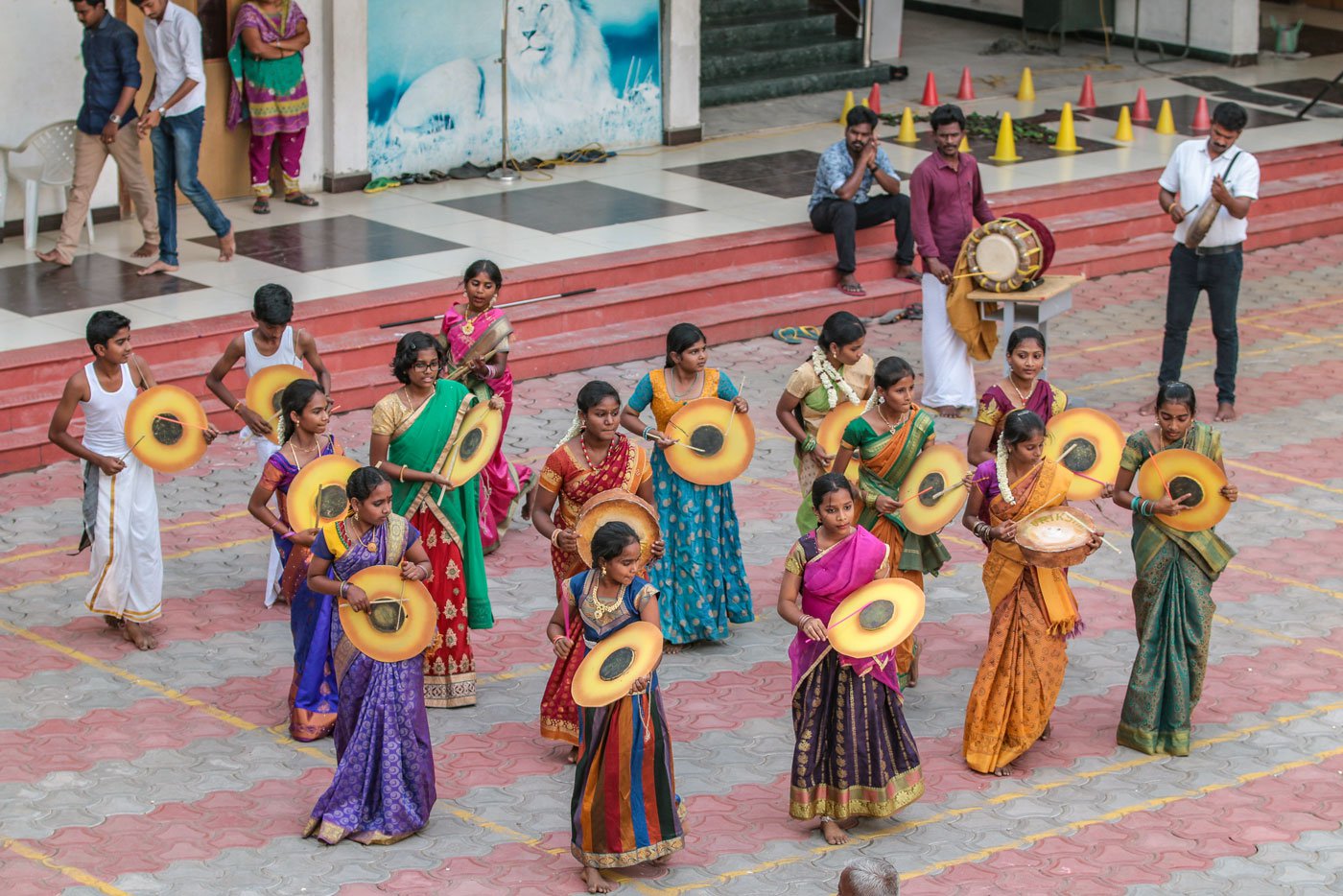
Children playing the frame drum for
parai attam
on ‘exhibition day’, the last day of a camp, in Tiruchengodu, Namakkal district
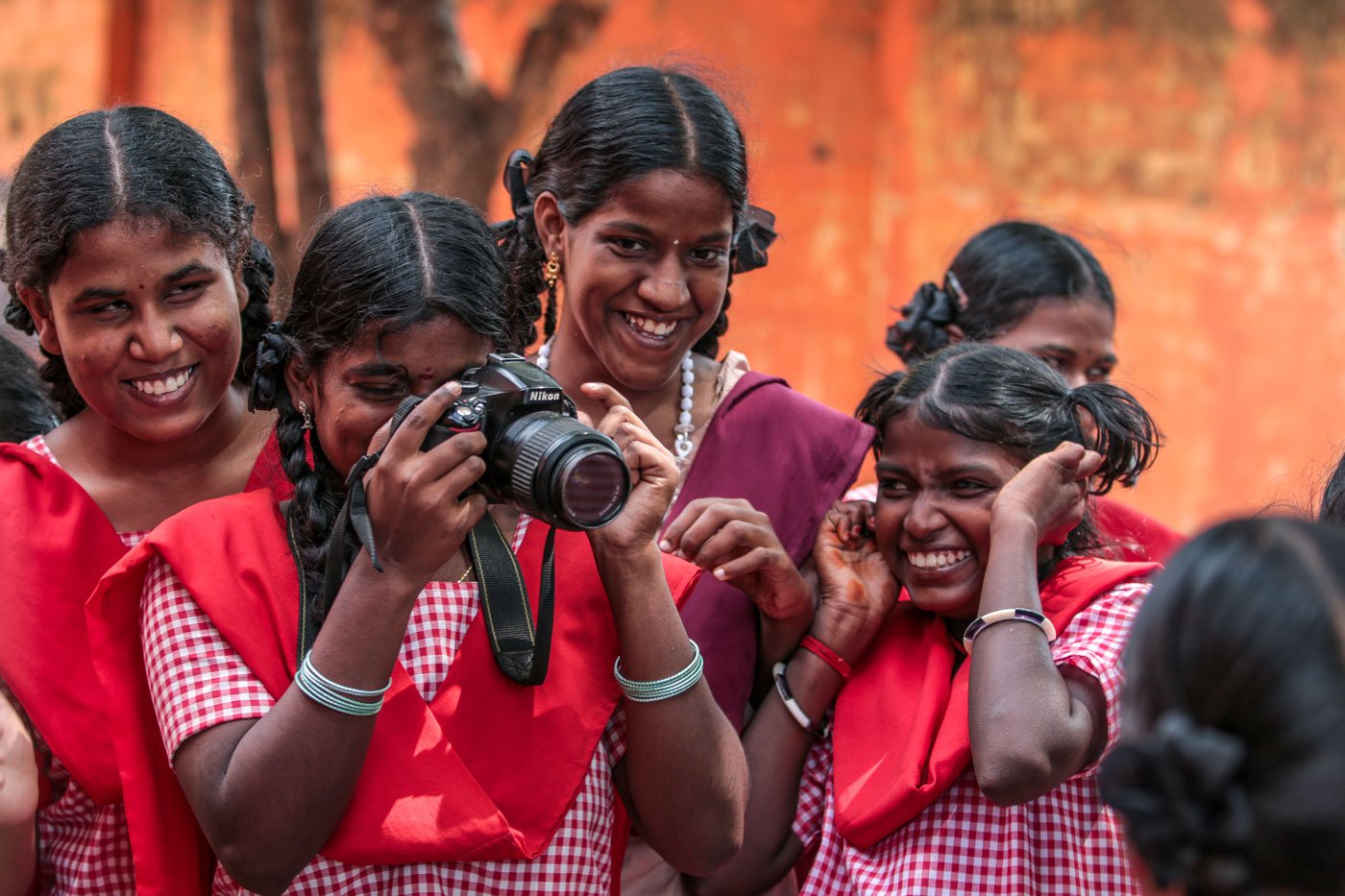
In Thanjavur, partially sighted girls taking photographs
He knows how to create beautiful moments. Moments in which kids and adults smile. He helped me recreate such moments with my own parents. When I was wandering aimlessly without a job after finishing my course in Engineering, when I started developing an interest in photography, Ezhil anna told me to be with my parents too. He shared stories about his relationship with his mother; how she had single-handedly raised him and his four sisters after his father’s death. It is through these conversations about his own mother’s struggle that Ezhil anna made me think about my parents’ efforts in raising me. That is how I came to value my mother, photographed her, and wrote about her.
When I started travelling with Ezhil anna , I also began to learn to organise plays, draw and paint, create colours, and started teaching kids photography. It opened a world of conversation between children and me. I listened to their stories and documented their lives in photographs. When I took photos after talking to them, playing with them, dancing and singing with them, it became a celebration of sorts. I went to their homes with them, ate with them, spoke to their parents. I realised that magic happens when I take photographs after conversations with them, after sharing time with them.
In the last 22 years, since Ezhil anna started Kaliman Viralgal, he has managed to bring magic and light to every life he touched. “We offer academic guidance to tribal children. We teach them the importance of education. We also teach girl children self-defence. We could see the children gaining self-confidence when they got trained in self-defence,” he says. The idea, for him, is to believe in our children, to inculcate rational thinking and freedom of thought and expression.
“We believe all lives are equal and we teach them that,” he says. “In their happiness, I derive mine.”
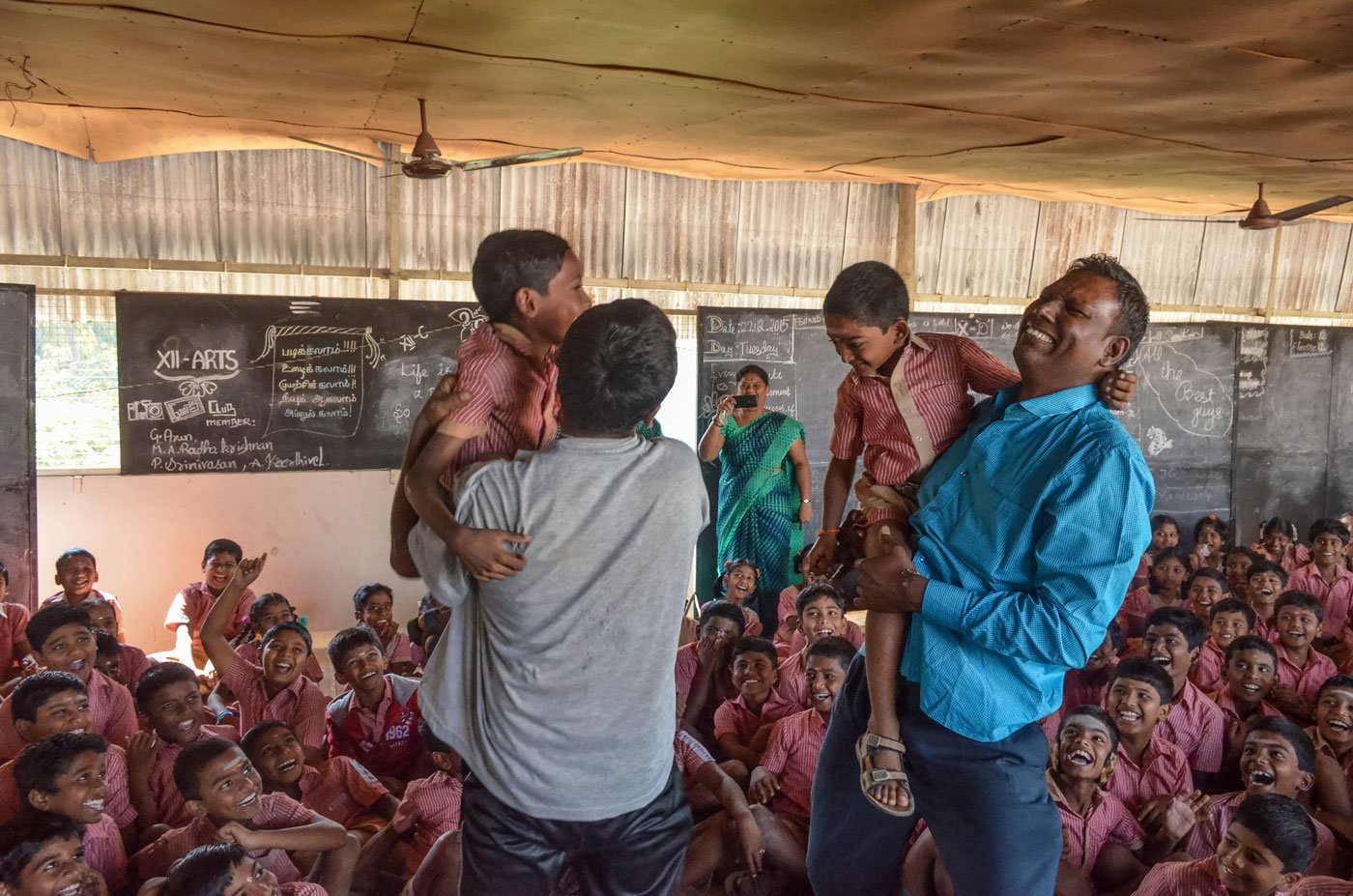
Ezhil anna leading a theatrical exercise, ‘mirror’ , which has filled the room with children's smiles at a school in Coimbatore
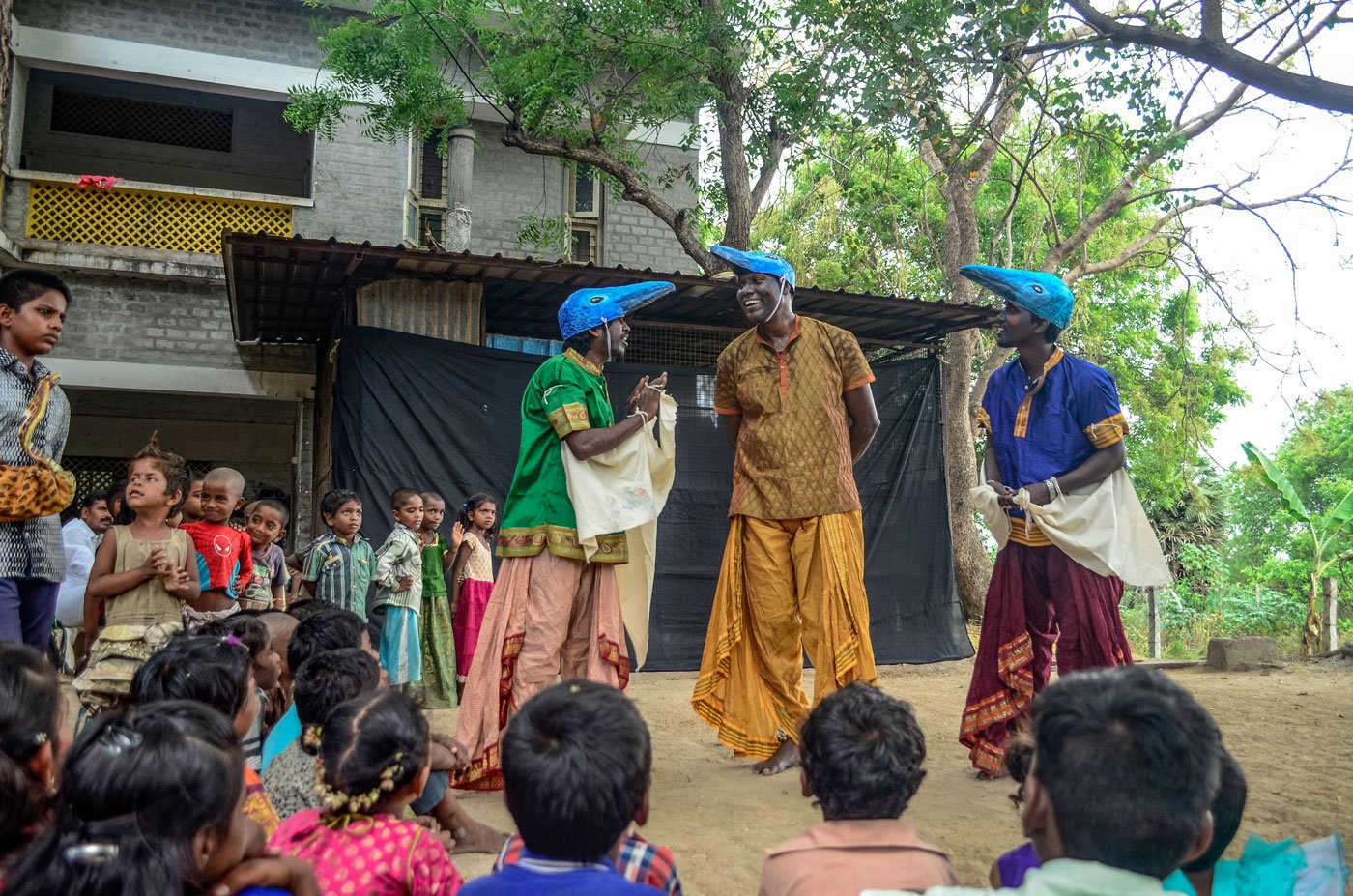
Ezhil anna and his team enacting a play about birds in Nagapattinam
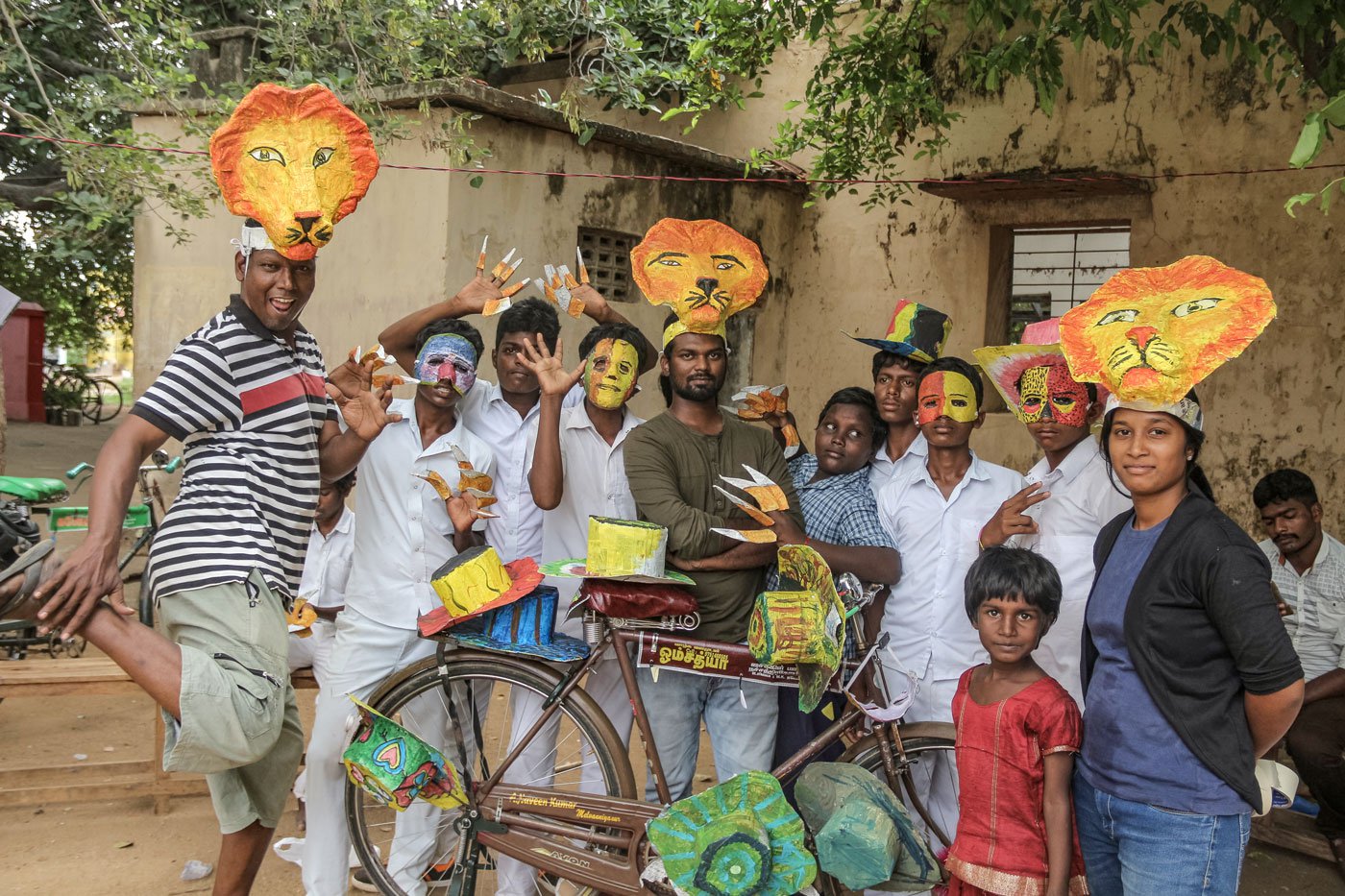
Ready to perform a play, Lion King, with masks, costumes and painted faces, in Tiruvannamalai
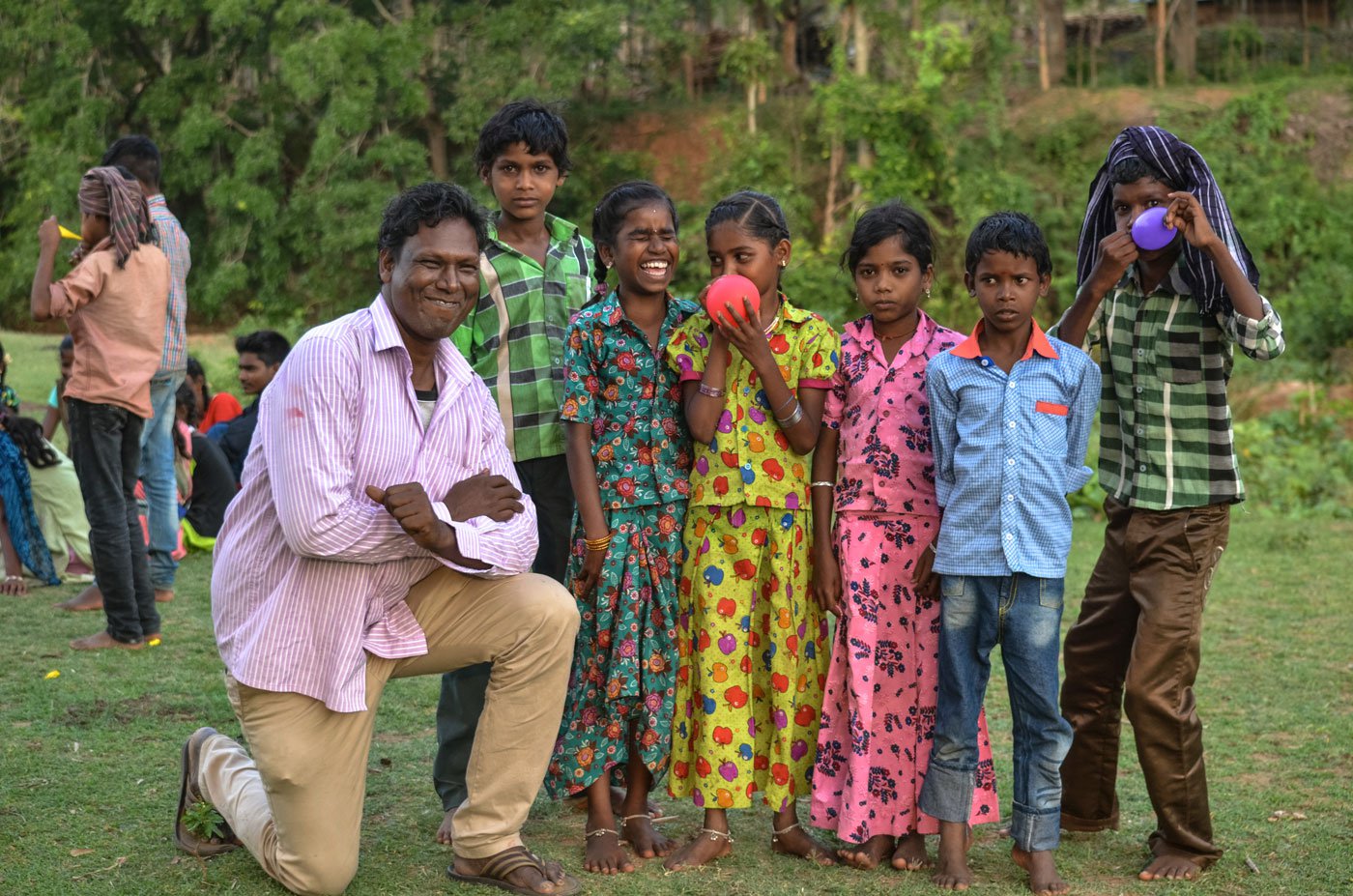
Ezhil anna with children in Sathyamangalam. You cannot take children out of his life. He is a man of charm and action when it comes to kids
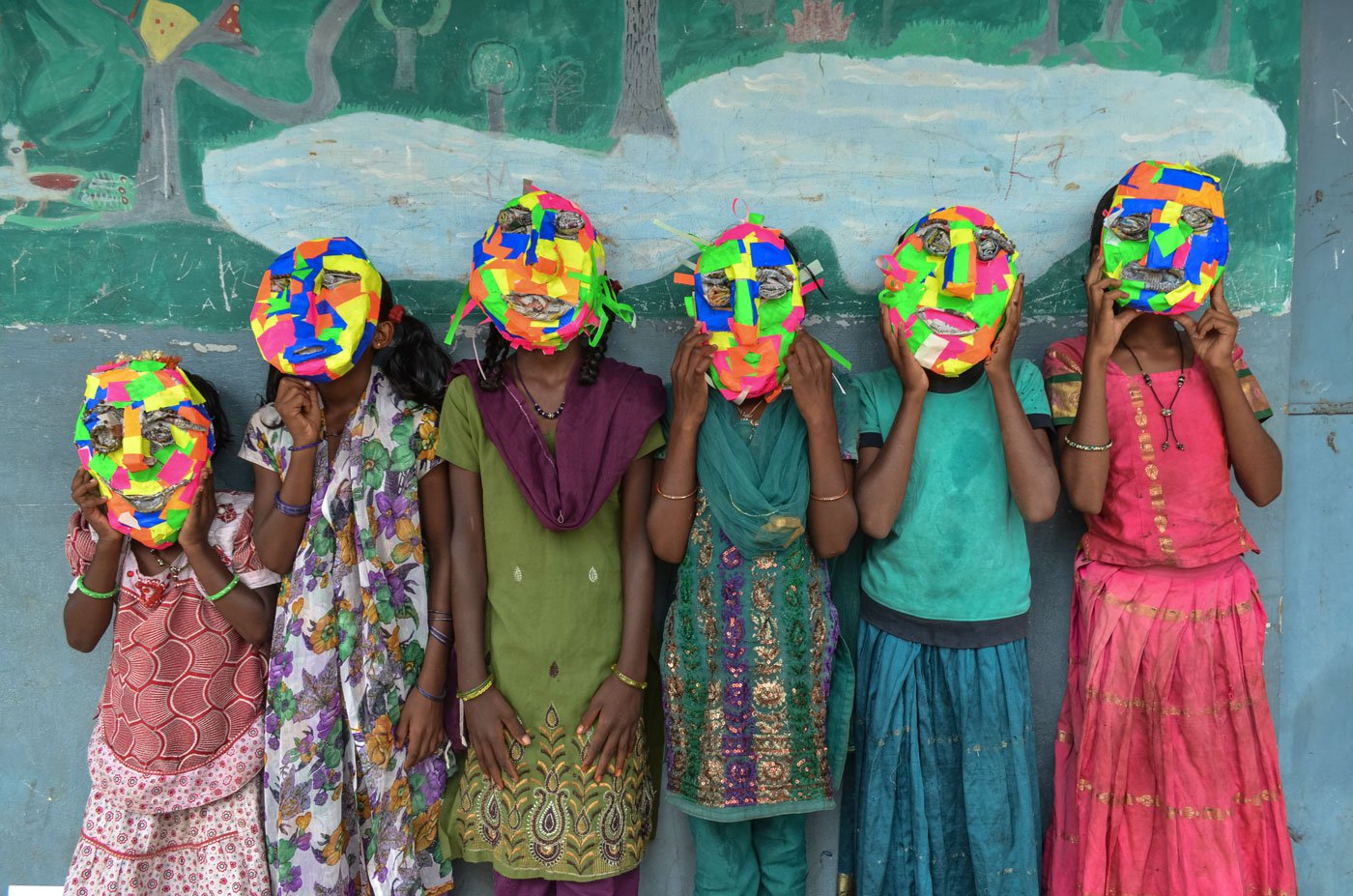
In Javadhu hills, children pose with paper masks they have made
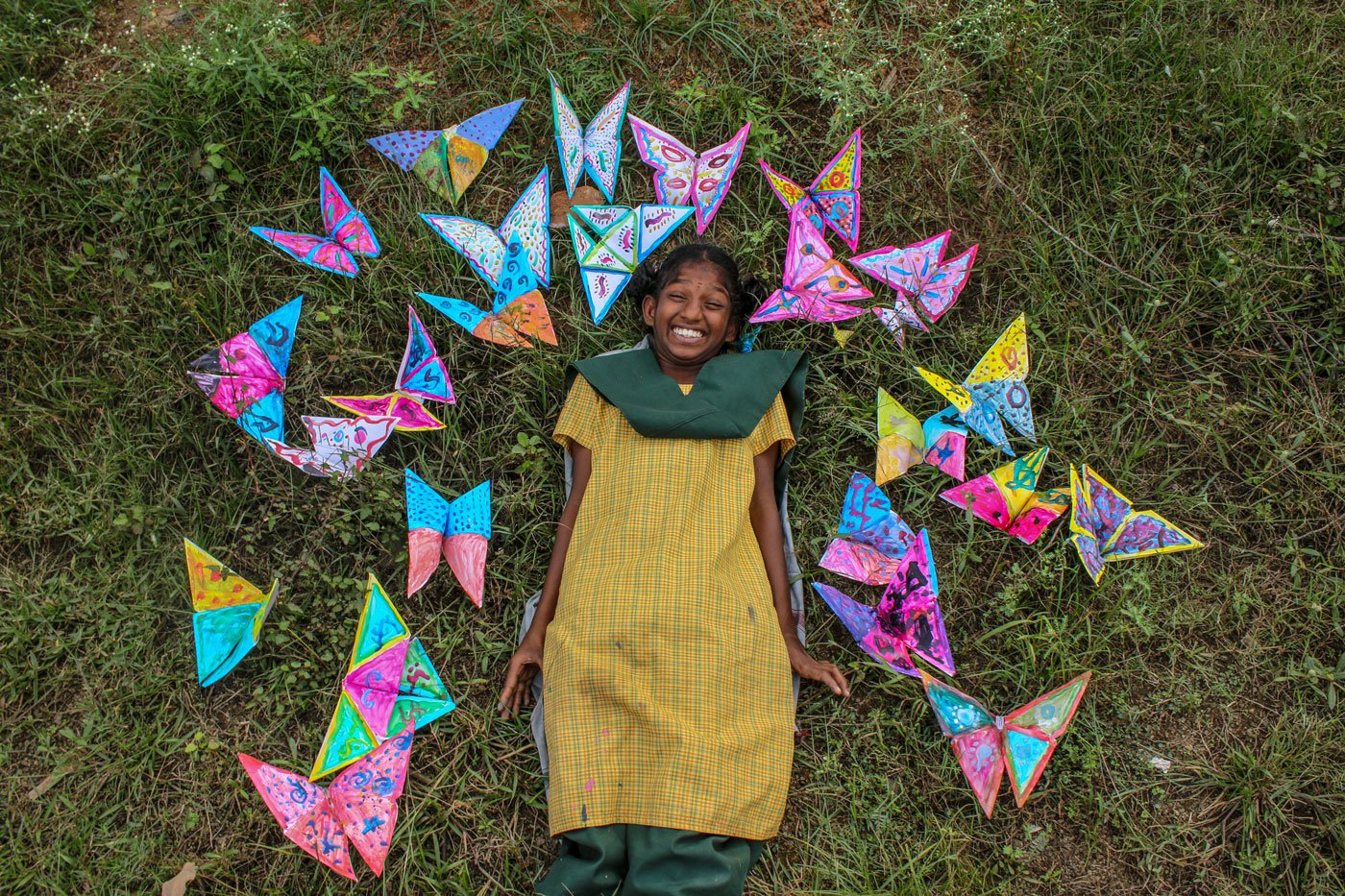
A child surrounded by paper butterflies made during an origami workshop session at a school for the hearing and speech impaired in Kancheepuram
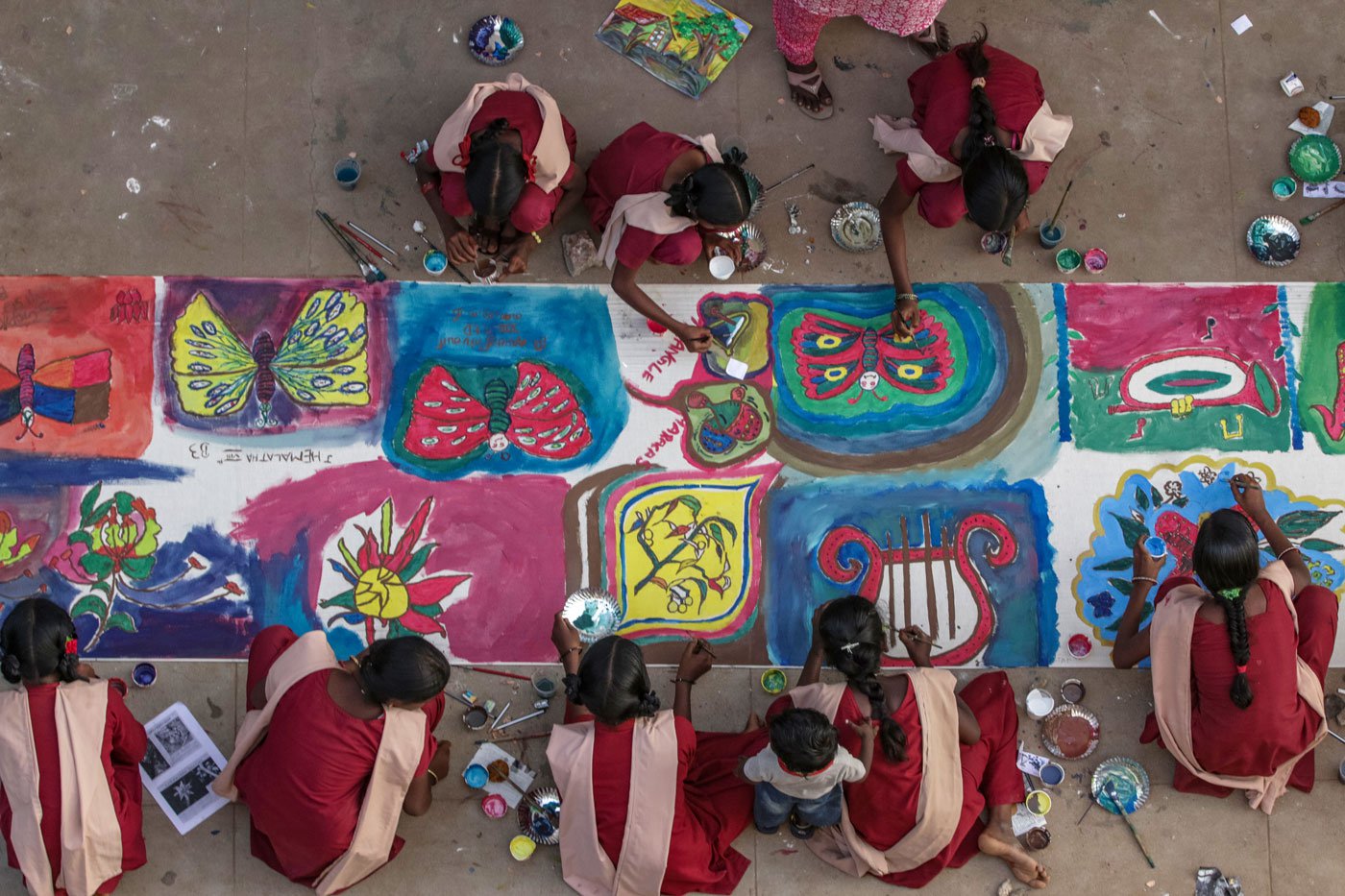
In Perambalur, children drawing their own posters for stage decoration. The stage was made from paper and cloth
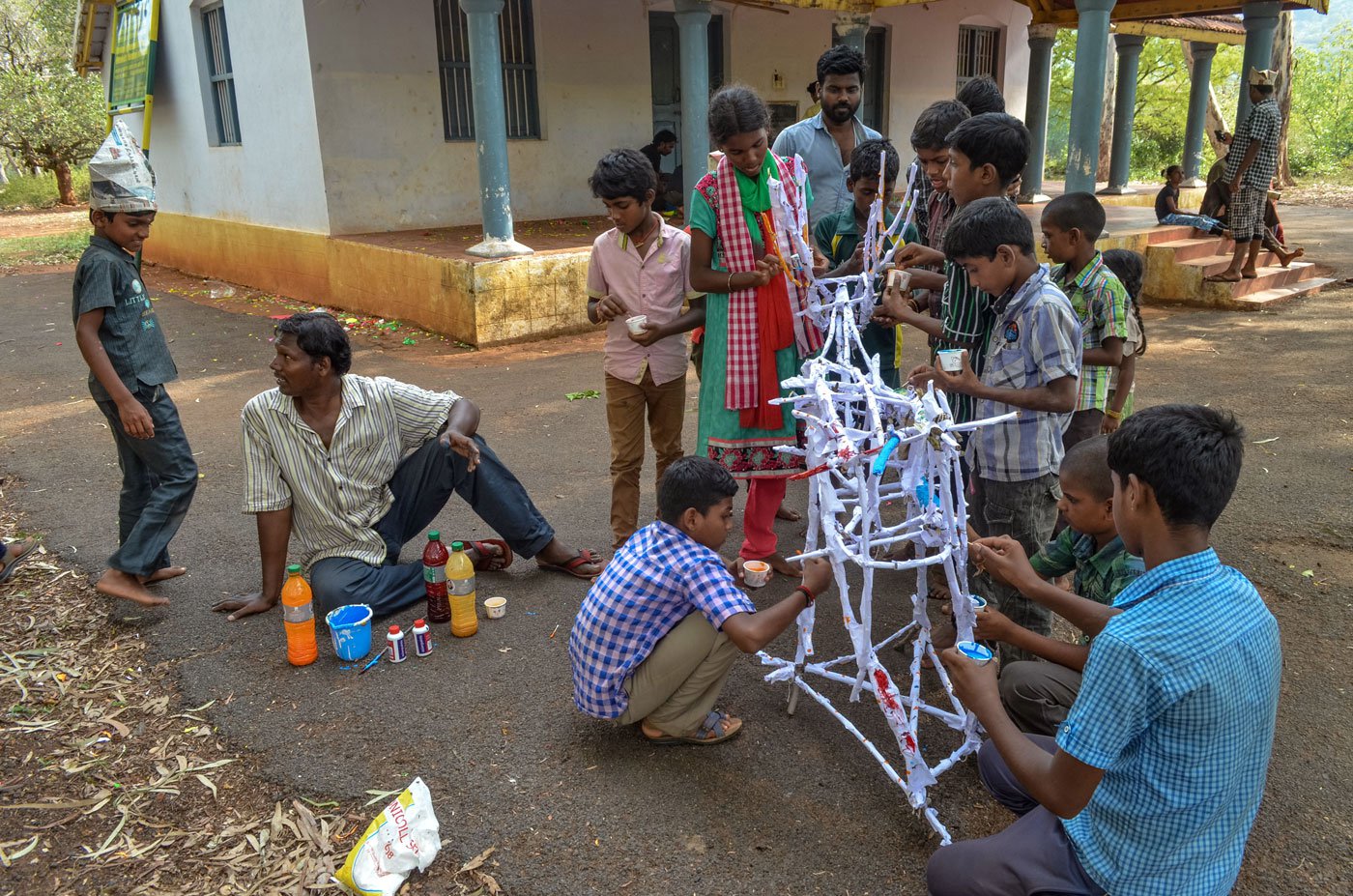
Ezhil anna and children making an animal model using branches from trees around them in the Javadhu hills
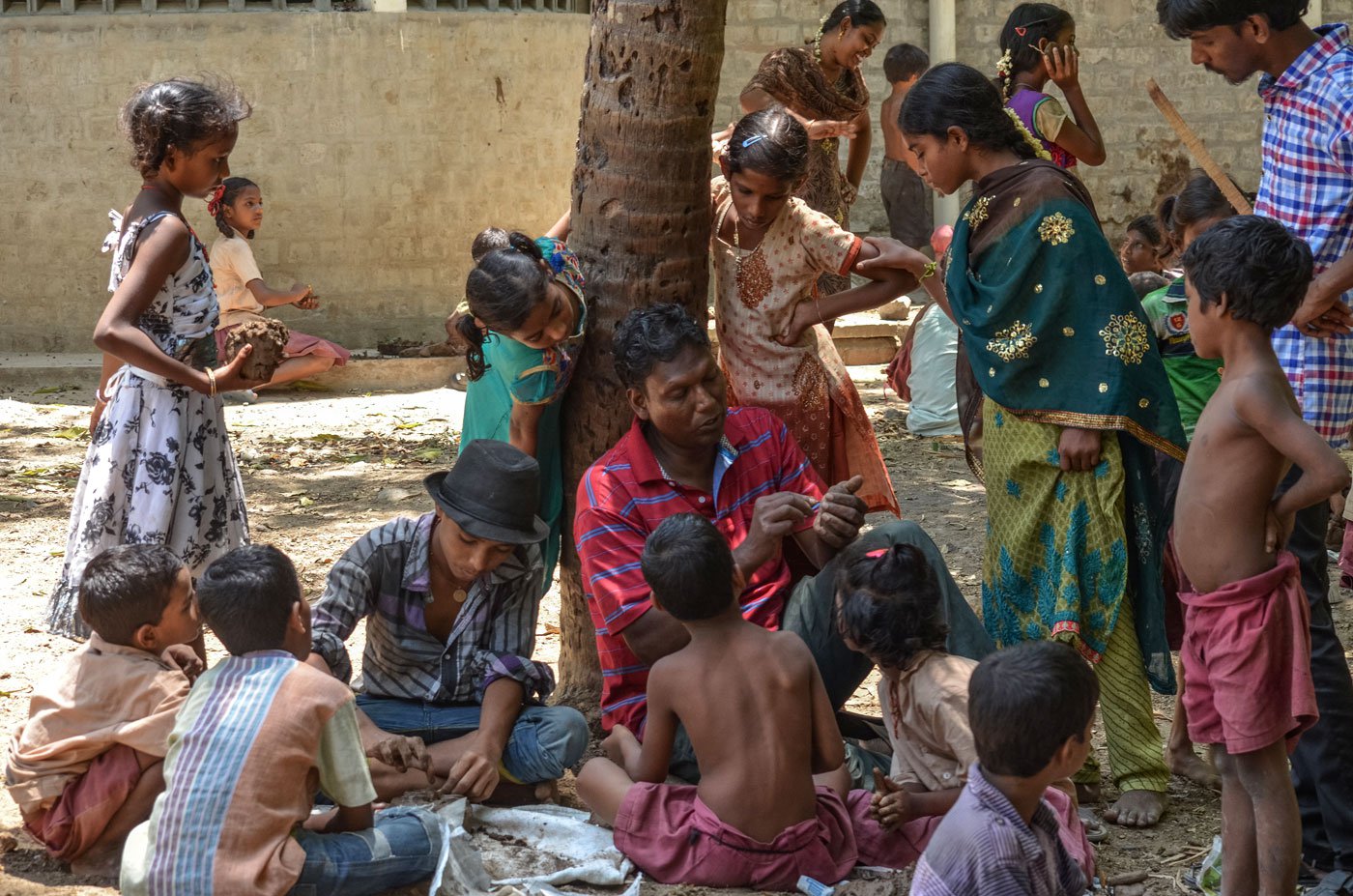
Sitting with children in the premises of a school in Nagapattinam
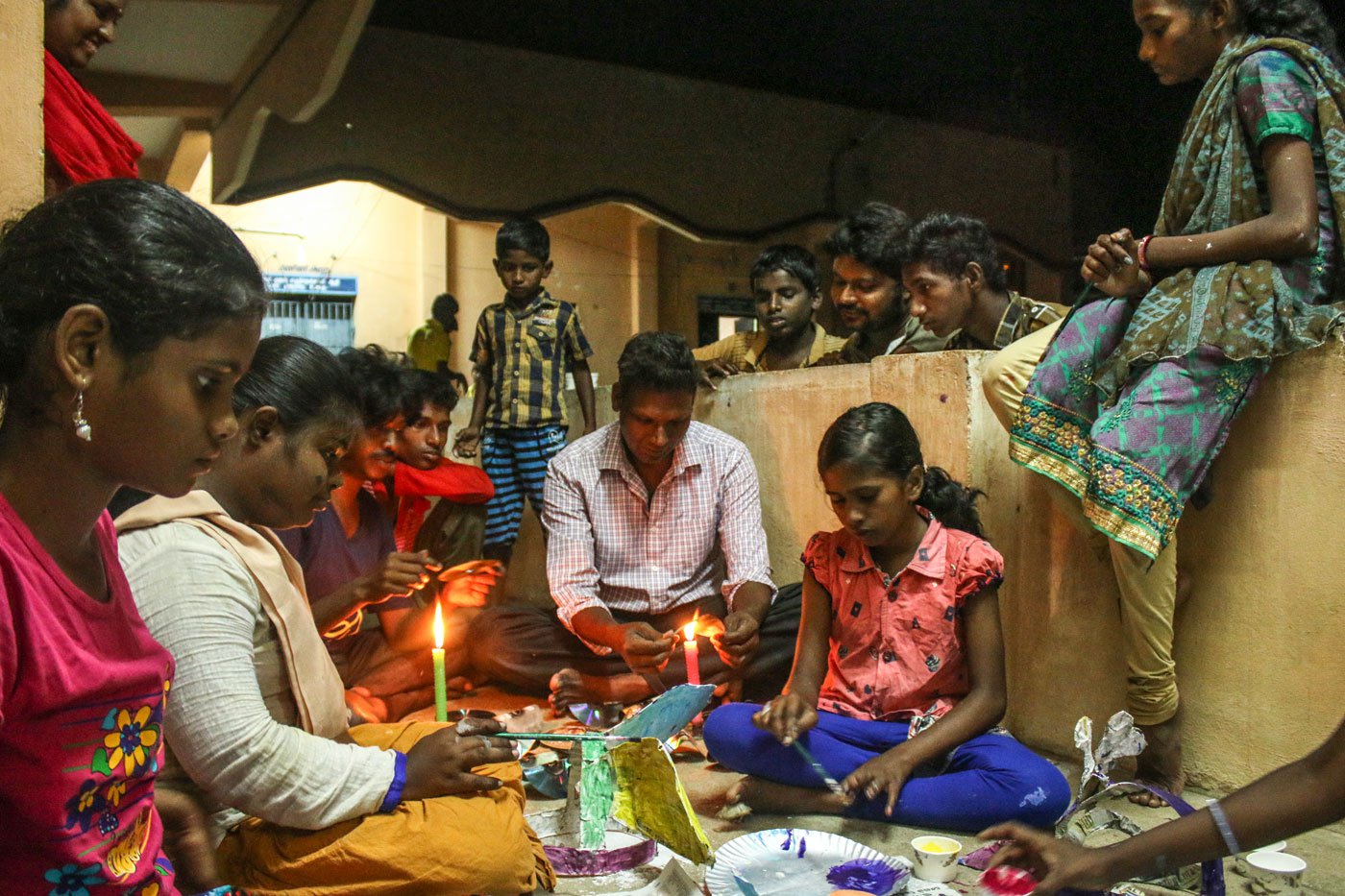
Hostel children at the school for hearing impaired kids in Kancheepuram making properties with old CDs
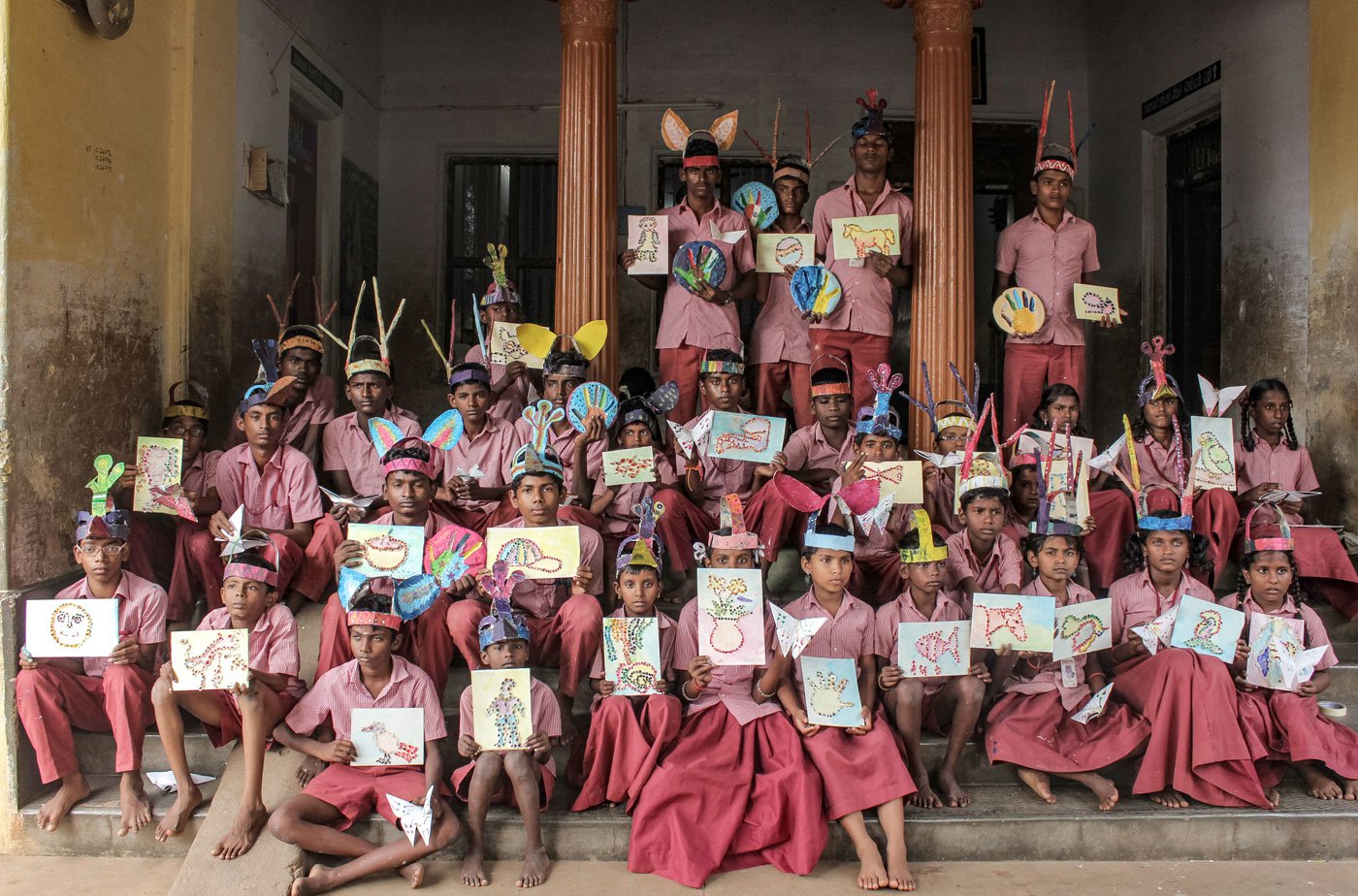
Children displaying their artworks in a school in Salem
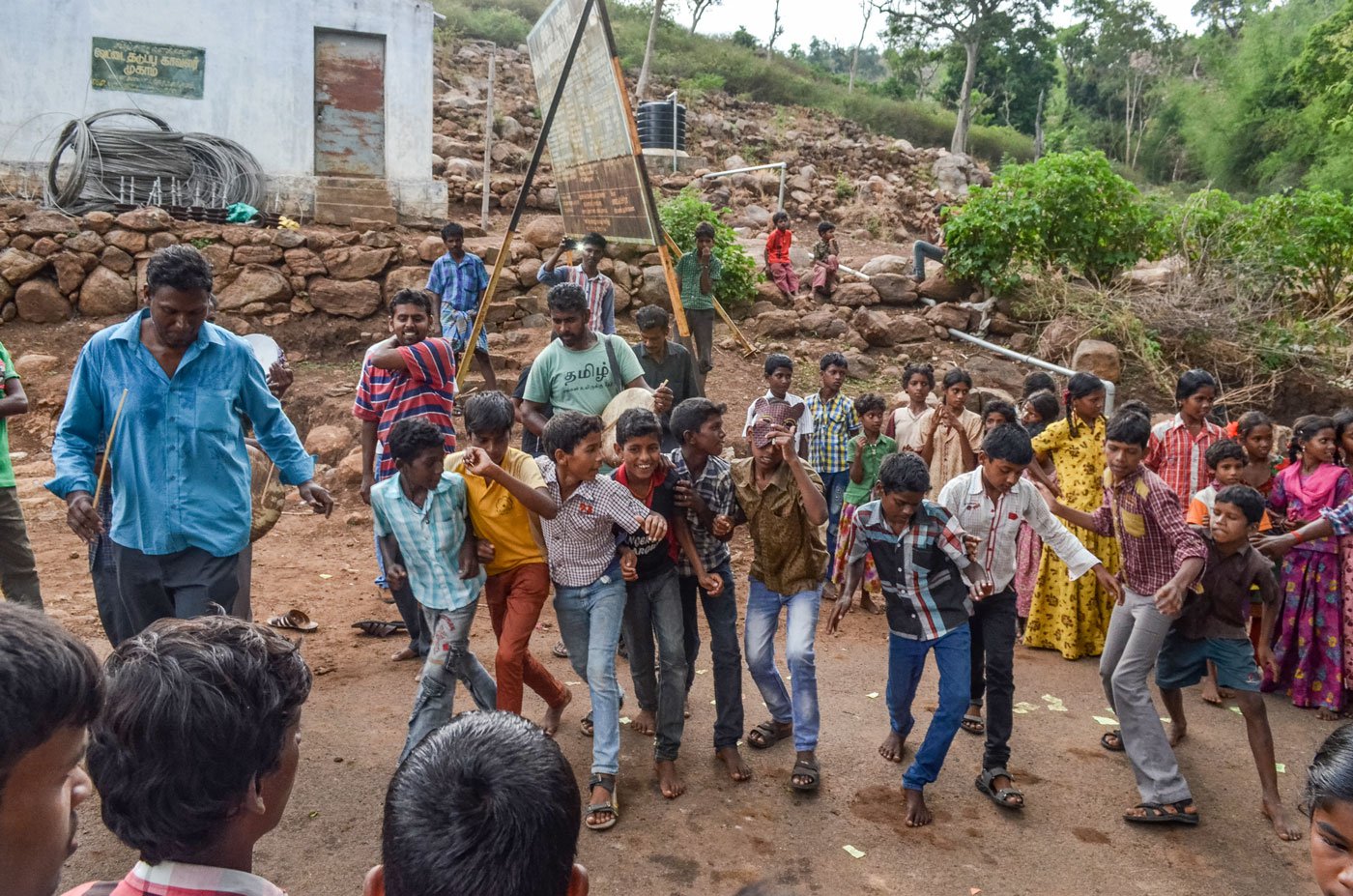
Ezhil anna with children on exhibition day as they welcome the village to see the artworks made at the camp in Sathyamangalam
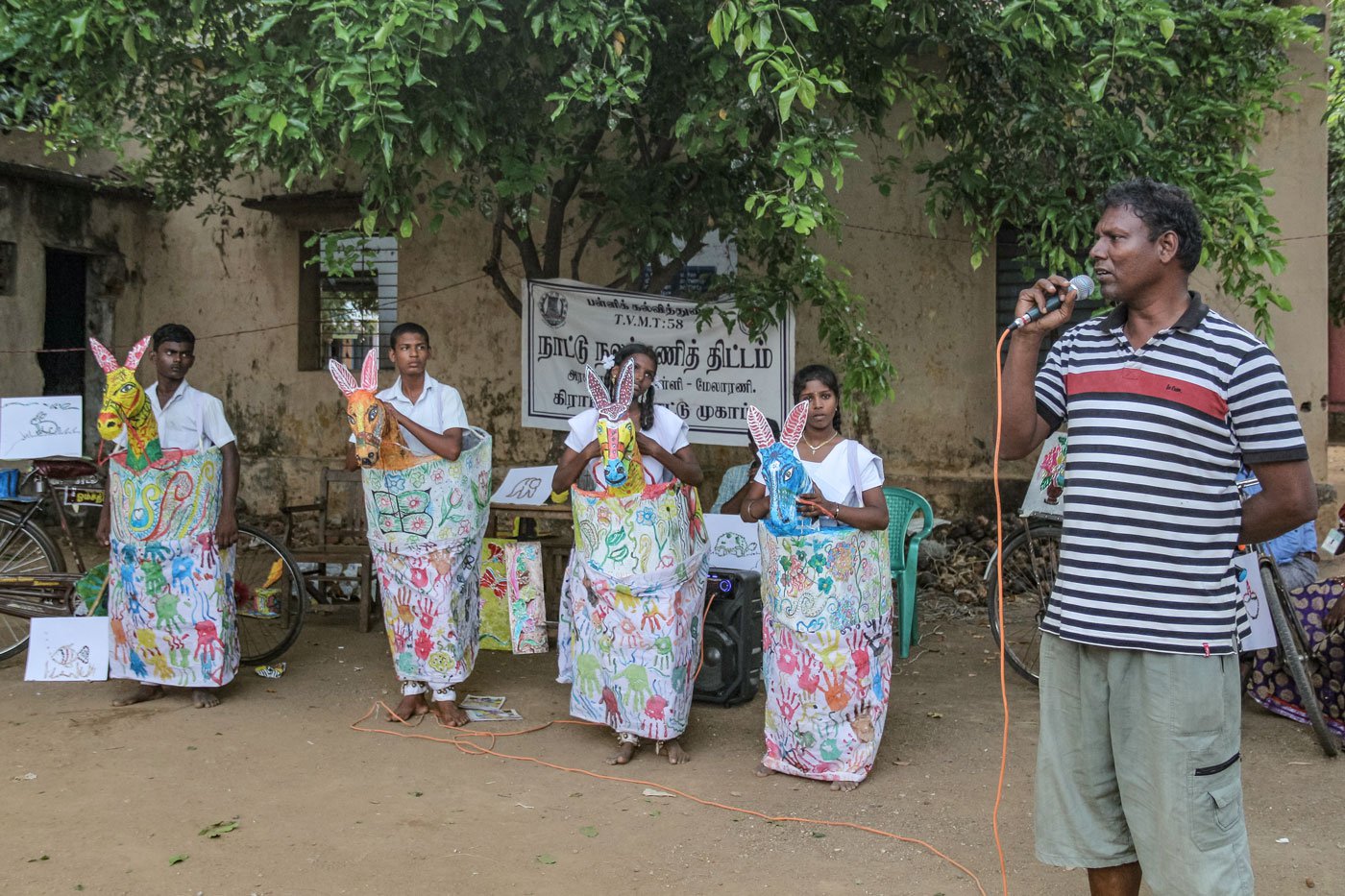
Ezhil anna introducing poi kal kuthurai attam, a folk dance, on the exhibition day in Kaveripattinam . The poi kal kuthurai (horse with fake legs) is made from cardboard and cloth
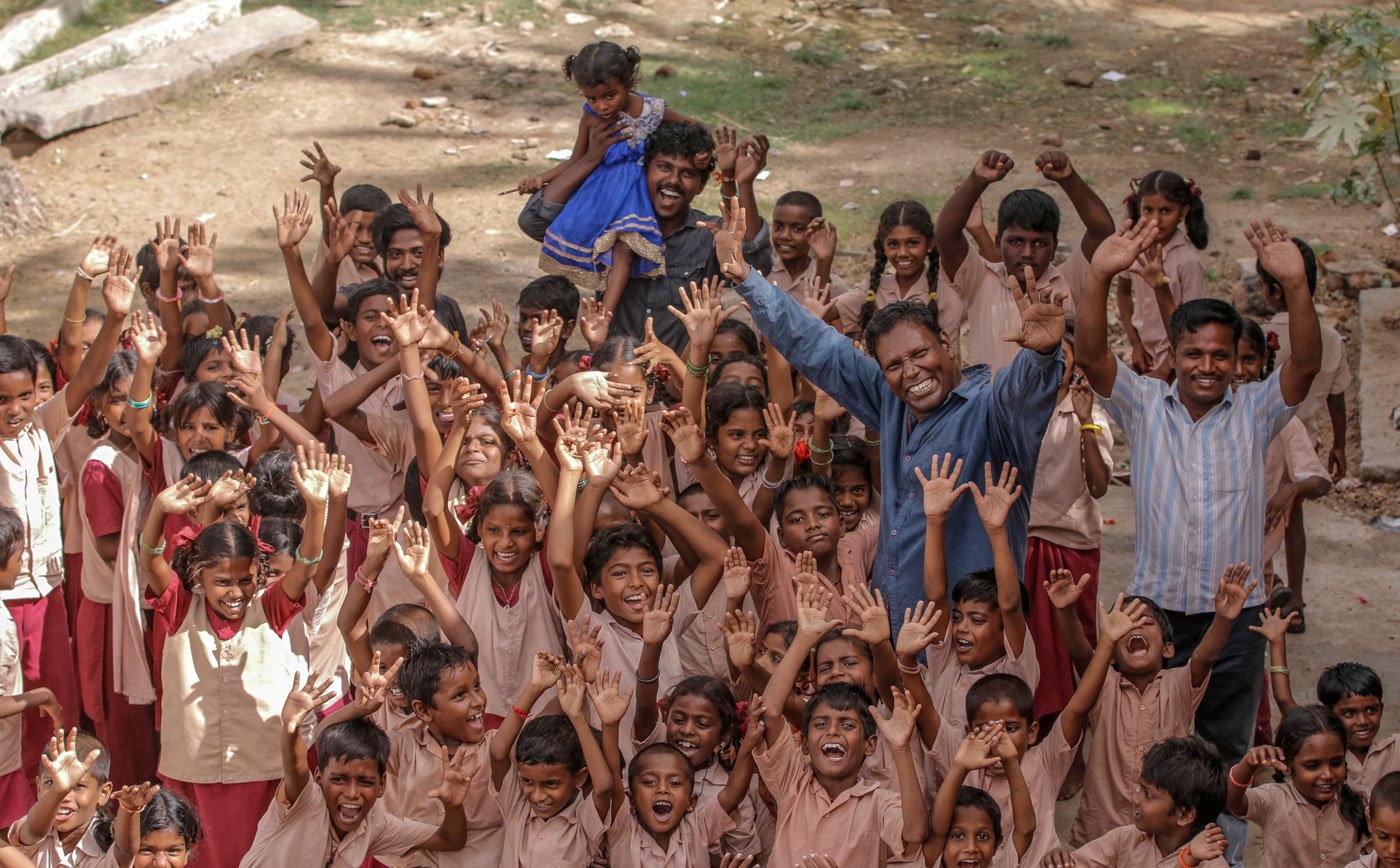
On the last day of a camp in Kaveripattinam, Ezhil anna' s team and the children shout ‘paprapa bye bye, bye bye paprapa‘
The author would like to thank Kavitha Muralidharan for all her work in the translation of this essay, and Aparna Karthikeyan for her inputs.
Postscript: Just as this essay was getting prepared for publication, on July 23, 2022, R. Ezhilarasan was diagnosed with Guillain-Barré syndrome, a serious neurological disorder in which the body's immune system attacks the nerves. The disease affects the peripheral nervous system and can lead to muscle weakness and paralysis.
